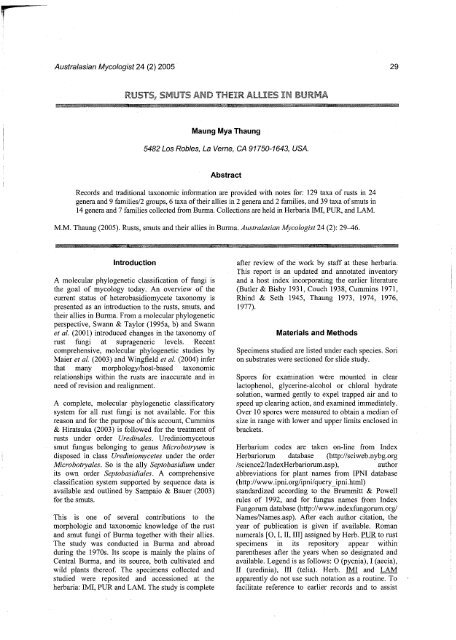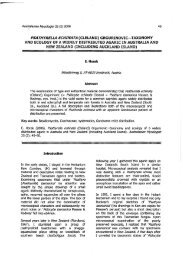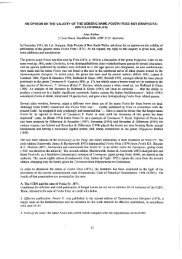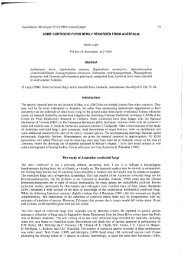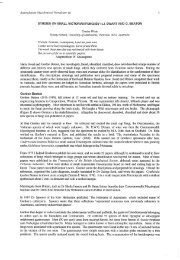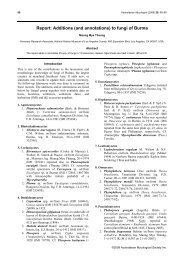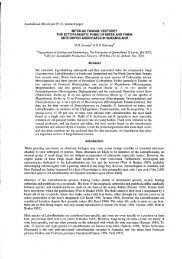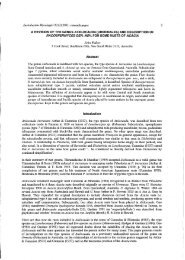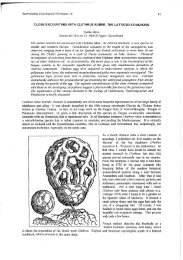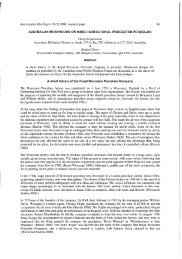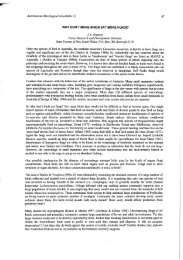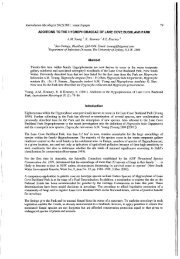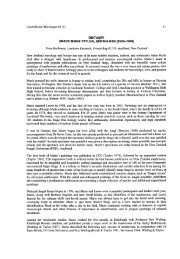rusts, smut? - The Australasian Mycological Society
rusts, smut? - The Australasian Mycological Society
rusts, smut? - The Australasian Mycological Society
Create successful ePaper yourself
Turn your PDF publications into a flip-book with our unique Google optimized e-Paper software.
RUSTS, SMUT? THEIR ALLIES O PJJRMA<br />
introduction<br />
A molecular phylogenetic classification of fungi is<br />
the goal of mycology today. An overview of the<br />
current status of heterobasidiomycete taxonomy is<br />
presented as an introduction to the <strong>rusts</strong>, <strong>smut</strong>s, and<br />
their allies in Burma. From a molecular phylogenetic<br />
perspective, Swann & Taylor (1995a, b) and Swann<br />
et al. (2001) introduced changes in the taxonomy of<br />
rust fungi at suprageneric levels. Recent<br />
comprehensive, molecular phylogenetic studies by<br />
Maier et al. (2003) and Wingfield et al. (2004) infer<br />
that many morphology/host-based taxonomic<br />
relationships within the <strong>rusts</strong> are inaccurate and in<br />
need of revision and realignment.<br />
A complete, molecular phylogenetic classificatory<br />
system for all rust fungi is not available. For this<br />
reason and for the purpose of this account, Cummins<br />
& Hiratsuka (2003) is followed for the treatment of<br />
<strong>rusts</strong> under order Uredinales. Urediniomycetous<br />
<strong>smut</strong> fungus belonging to genus Microbotryum is<br />
disposed in class Urediniomycetes under the order<br />
Microbotryales. So is the ally Septobasidium under<br />
its own order Septobasidiales. A comprehensive<br />
classification system supported by sequence data is<br />
available and outlined by Sampaio & Bauer (2003)<br />
for the <strong>smut</strong>s.<br />
This is one of several contributions to the<br />
morphologic and taxonomic knowledge of the rust<br />
and <strong>smut</strong> fungi of Burma together with their allies.<br />
<strong>The</strong> study was conducted in Burma and abroad<br />
during the 1970s. Its scope is mainly the plains of<br />
Central Burma, and its source, both cultivated and<br />
wild plants thereof. <strong>The</strong> specimens collected and<br />
studied were reposited and accessioned at the<br />
herbaria: IMI, PUR and LAM. <strong>The</strong> study is complete<br />
Maung Mya Thaung<br />
5482 Los Robles, La Verne, CA 91750-1643, USA.<br />
Abstract<br />
Records and traditional taxonomic information are provided with notes for: 129 taxa of <strong>rusts</strong> in 24<br />
genera and 9 families/2 groups, 6 taxa of their allies in 2 genera and 2 families, and 39 taxa of <strong>smut</strong>s in<br />
14 genera and 7 families collected from Burma. Collections are held in Herbaria DVII, PUR, and LAM.<br />
M.M. Thaung (2005). Rusts, <strong>smut</strong>s and their allies in Burma. <strong>Australasian</strong> Mycologist 24 (2): 29^16.<br />
after review of the work by staff at these herbaria.<br />
This report is an updated and annotated inventory<br />
and a host index incorporating the earlier literature<br />
(Butler & Bisby 1931, Couch 1938, Cummins 1971,<br />
Rhind & Seth 1945, Thaung 1973, 1974, 1976,<br />
1977).<br />
Materials and Methods<br />
Specimens studied are listed under each species. Sori<br />
on substrates were sectioned for slide study.<br />
Spores for examination were mounted in clear<br />
lactophenol, glycerine-alcohol or chloral hydrate<br />
solution, warmed gently to expel trapped air and to<br />
speed up clearing action, and examined immediately.<br />
Over 10 spores were measured to obtain a median of<br />
size in range with lower and upper limits enclosed in<br />
brackets.<br />
Herbarium codes are taken on-line from Index<br />
Herbariorum database (http://sciweb.nybg.org<br />
/science2/IndexHerbariorum.asp), author<br />
abbreviations for plant names from IPNI database<br />
(http ://www. ipni.org/ipni/query_ipni .html)<br />
standardized according to the Brummitt & Powell<br />
rules of 1992, and for fungus names from Index<br />
Fungorum database (http://www.indexfungorum.org/<br />
Names/Names.asp). After each author citation, the<br />
year of publication is given if available. Roman<br />
numerals [O, I, II, III] assigned by Herb. PUR to rust<br />
specimens in its repository appear within<br />
parentheses after the years when so designated and<br />
available. Legend is as follows: O (pycnia), I (aecia),<br />
II (uredinia), III (telia). Herb. MI and LAM<br />
apparently do not use such notation as a routine. To<br />
facilitate reference to earlier records and to assist
any future revisit or revision, names mentioned in<br />
older literature are retained, if any, as synonyms<br />
with (=) identical sign in front enclosed in brackets.<br />
Notes are sometimes supplied on specimens or their<br />
fungal parasites. Classification is based on Cummins<br />
& Hiratsuka (2003) for the <strong>rusts</strong>, and follows Bauer<br />
and Oberwinkler (Sampaio & Bauer 2003) and<br />
Vanky (2002, 2004) for the <strong>smut</strong>s and their allies.<br />
Taxa are enumerated in alphabetical and hierarchical<br />
order.<br />
Taxonomy<br />
Species determined and/or recorded as<br />
present in Burma<br />
Class UREDINIOMYCETES Swann & Taylor<br />
Order UREDINALES Arthur<br />
Family CHACONIACEAE Cummins & Y. Hirats.<br />
1983<br />
1. Achrotelium ichnocarpi Syd. 1928 [II, III] on<br />
leaves of Ichnocarpus sp.; Myitnge, 14-X-1971<br />
(PUR N3865). Note: Teliospores are smaller.<br />
2. Chaconia butleri (Syd. & P. Syd.) Mains 1938<br />
[II] on leaves of Jasminum auriculatum Vahl;<br />
Maymyo, l-x-1971 (IMI 164841), (PUR<br />
F19624).<br />
3. Hemileia holarrhenae Syd. & P. Syd. 1914 on<br />
leaves of Holarrhena antidysenterica Wall.;<br />
Myitkyina, 26-xii-1971 (IMI 164836), (PUR<br />
F19620), 28-xii-1972 (LAM 2201946).<br />
4. Hemileia randiicola Thaung 1976 on leaves of<br />
Randia sp. (aff. dumetorum Lam.); North of<br />
Kyaukchaw en route Maymyo, 21-ii-1974 (IMI<br />
185232, holotype).<br />
5. Hemileia vastatrix Berk. & Broome 1869 on<br />
leaves of Coffea arabica L.; Maymyo, 1971<br />
(PUR F19619); Sinthawt village, east of Yezin,<br />
25-viii-1977 (LAM 220218a); Leiktho (Rhind &<br />
Seth 1945). Note: Hyperparasite Verticillium<br />
hemileiae Bouriquet 1946 (LAM 220218b) is<br />
also present.<br />
6. Maravalia echinulata (Niessl ex Rabenh.) Y. Ono<br />
1984 (= Scopella echinulata (Niessl) Mains<br />
1939) [II] on leaves of Madhuca longifolia<br />
Macbride; Mandalay, 20-iii-1971 (IMI 155991),<br />
27-X-1971 (IMI 161589); Madhuca latifolia<br />
Macbride; Mandalay, 28-xi-1974 (LAM<br />
220082). Note: Numerous fine paraphyses<br />
mainly clavate at the tips.<br />
7. Maravalia gentilis (Syd.) Y. Ono 1984 (=<br />
Scopella gentilis (Syd.) Mundk. & Thirum.<br />
1950) [II] on leaves of Sideroxylon sp.;<br />
Mandalay, l-x-1971 (PUR F19589), 30-X-1977<br />
(LAM 220943). Note: Germ pores tend to be<br />
higher than typical and first recorded on this<br />
host genus.<br />
8. Maravalia mimusops (Cooke) Y. Ono 1984 (=<br />
Scopella mimusops (Cooke) Cummins 1950) [II]<br />
on leaves of Mimusops elengi L.; Burma (LAM<br />
220452). Compare with Maravalia aulica (Syd.)<br />
Y. Ono 1984.<br />
9. Olivea colebrookiana Thirum. & Yadav 1955 [II]<br />
on leaves of a member (Vernacular name: Ponmagyi)<br />
of Labiatae; Fftonbo Farm, S.S.S., 12-ii-<br />
1973 (IMI 173536). Uredo colebrookiae Barclay<br />
— the uredinial stage of Olivea colebrookiana.<br />
Note: Uredinia subepidermal, erumpent, with<br />
peripheral incurved clavate paraphyses;<br />
urediniospores globoid or ovoid, pale yellow,<br />
echinulate, (16-) 19-22 (-26) x 16-17 um.<br />
10. Olivea tectonae (T.S. Ramakr. & K. Ramakr.)<br />
Thirum. 1949 [II, III] on leaves of Tectona<br />
grandis L. f.; Kyaukpadaung, 25-xii-1977 (LAM<br />
220454); (Rhind & Seth 1945). Uredo tectonae<br />
Racib. 1900 — the uredinial stage of Olivea<br />
tectonae.<br />
Family COLEOSPORIACEAE Dietel 1900<br />
1. Coleosporium tussilaginis (Pers.) Berk. 1860 (=<br />
Coleosporium campanulae Cooke 1865) on<br />
leaves of Pinus insularis Endl.; Haka, Chin<br />
Hills, 3-V-1972 (IMI 166371). Concerning the<br />
nomenclature of this species see Laundon<br />
(1967).<br />
Family MELAMPSORACEAE Dietel 1897<br />
1. Melampsora euphorbiae (C. Schub.) Castagne<br />
1843 on leaves of Euphorbia geniculata Ortega;<br />
Maymyo, 15-V-1971 (IMI 157605), 17-xii-1975<br />
(IMI 199753, LAM 220043); E. rottiana<br />
Spreng; Tadau, l-iv-1972 (IMI 166362), 11-ii-<br />
1973 (LAM 220216); Myaung, 2-iii-1973 (IMI<br />
173547). Synonymy: Uredo euphorbiae<br />
(C. Schub.) Castagne. Based on host, this taxon<br />
could possibly be Melampsora euphorbiaegeniculatae<br />
F. Kern & Thurst. 1944. Note:<br />
Urediniospores 16-24 x 13-18 urn ; walls 2-<br />
3 um ; paraphyses capitate 19—24 x 16-22 um.<br />
2. Melampsora ricini E.A. Noronha 1952 (formerly<br />
as Melampsora euphorbiae (C. Schub.)<br />
Castagne) on leaves of Ricinus communis L.;<br />
Bassein, l-iv-1973 (IMI 175718).<br />
Family PHAKOPSORACEAE (Arthur)<br />
Cummins & Y. Hirats. 1983<br />
1. Cerotelium alienum (Syd., P. Syd. & E.J. Butler)<br />
Arthur 1925 on leaves of Spondias Ipinnata<br />
Kurz; Monywa, 2-U1978 (LAM 220566).<br />
2. Cerotelium desmium Arthur 1925 on leaves of<br />
Gossypium sp.; Allanmyo (Rhind & Seth 1945).
3. Cerotelium fici (E.J. Butler) Arthur 1917 [II] on<br />
leaves of Ficus carica L., Mandalay, 29-vi-1972<br />
(IMI 167181); Hlegu, 14-H-1980 (LAM<br />
220886), (Rhind & Seth 1945); Ficus infectoria<br />
Roxb., Gangaw, 21-xii-1977 (LAM 220565);<br />
Ficus palmata Forssk., Mandalay and Maymyo<br />
(Rhind & Seth 1945). <strong>The</strong> name Uredo fici<br />
Castagne is uredinial and cannot be used as the<br />
basionym for a telial rust.<br />
4. Crossopsora zizyphi (Syd., P. Syd. & EJ. Butler)<br />
Syd. & P. Syd. 1918 on leaves of Ziziphus<br />
rugosa Lam.; Maymyo, 16-ii-1974 (IMI<br />
182568).<br />
5. Dasturella bambusina Mundk. & Khesw. 1943<br />
on leaves of Bambusa sp.; Anisakhan near<br />
Maymyo, 2-V-1971 (IMI 160359); Syriam, 14iv-1972<br />
(LAM 220081).<br />
6. Dasturella divina (Syd.) Mundk. & Khesw. 1943<br />
on leaves of Dendrocalamus brandisii Kurz;<br />
Namalut Farm near Shweyawn, S.S.S., 12-ii-<br />
1973 (IMI 180204); Dendrocalamus strictus<br />
Nees, Kyaukchaw near Mandalay, 14-1-1975<br />
(IMI 192814a). Note: Carvalho et al. (2001)<br />
proposed Aecidium thaungii A.A. Carvalho,<br />
J.F. Hennen & M.B. Figueiredo 2001 to replace<br />
Aecidium randiicola Thaung 1976, a latter<br />
homonym of A. randicola Speg. 1925, named<br />
for the [0, I] stage of Dasturella divina q.v. on<br />
leaves and fruits of Randia aff. dumetorum Lam.<br />
from Kyaukchaw, east of Mandalay, collected<br />
on 7-ix-1974 (IMI 189040, holotype).<br />
7. Phakopsora dioscoreae Thaung 1974 [II, III] on<br />
leaves of Dioscorea burmanica Prain &<br />
Burkhill; Yankin Hill, Mandalay, 8-iv-1972<br />
(IMI 169370, holotype), (PUR F18333);<br />
Dioscorea sp., Kyaikhtiyo Range, 23-xi-1975<br />
(LAM 220044).<br />
8. Phakopsora euvitis Y. Ono 2000 [II, III] (=<br />
Physopella ampelopsidis (Dietel & P. Syd.)<br />
Cummins & Ramachar. 1958) on leaves of Vitis<br />
labrusca L. and Vitis vinifera L.; Mandalay, 12viii-1969<br />
(IMI 142054); on leaves of Vitis spp.,<br />
Mandalay, 1971 (PUR 66790); 5-X-1977 (LAM<br />
220327), (Ono 2000).<br />
9. Phakopsora pachyrhizi Syd. & P. Syd. 1914 [II]<br />
on leaves of Erythrina sp.; Mandalay, 29-vi-<br />
1972 (IMI 167183), 19-X-1973 (PUR F19617),<br />
Pyinmana, 30-xii-1977 (LAM 220914);<br />
Pachyrhizus angulatus Rich, Myitkyina, 24-xii-<br />
1977 (LAM 220323); Glycine max Merrill.;<br />
Myitkyina, l-i-1972 (PUR F18672), Paukmyo,<br />
9-i-1977 (LAM 220558), (Ono et al. 1992).<br />
Uredo erythrinae Henn. 1908 — the uredinial<br />
stage of Phakopsora pachyrhizi.<br />
10. Phakopsora phyllanthi Dietel 1910 [II, III] on<br />
leaves of Phyllanthus nanus Hook, f.; Mandalay,<br />
23-iii-1971 (IMI 155990), l-xii-1971 (PUR<br />
F89683); Phyllanthus distichus Miill. Arg.;<br />
Mandalay, 1971 (PUR F89684), 22-xi-1975<br />
(LAM 220076), (Rhind & Seth 1945). See also<br />
Kernkampella emblicae (Syd. & P. Syd.)<br />
G.F. Laundon 1975 on Phyllanthus emblica L.,<br />
and Aecidium phyllanthi Henn. 1892 on<br />
Phyllanthus reticulatus Poir.<br />
11. Phakopsora zizyphi-vulgaris Dietel 1910 on<br />
leaves of Ziziphus jujuba Mill.; Mandalay, 4-iv-<br />
1971 (IMI 156314), (PUR F19616), (Rhind &<br />
Seth 1945).<br />
A. 'Phakopsora' sp. [II, III] on an unknown shrub;<br />
Rangoon (Mount Pleasant Road at Chinchaung<br />
Avenue), 27-xii-1975 (IMI 191505), (LAM<br />
220576).<br />
B. 'Phakopsora' sp. on Eulaliopsis binata (Retz.)<br />
C.E. Hubb. (Vernacular name: Tha-mun-myet);<br />
Mount Popa, 17-ix-1972 (IMI 170091). Note:<br />
Fungal material immature.<br />
Family PHRAGMIDIACEAE Corda 1837<br />
1. Phragmidium burmanicum Syd. & P. Syd. 1912<br />
[III] on leaves of Rubus lasiocarpus Sm.;<br />
Maymyo, 28-i-1974 (IMI 182566), (Rhind &<br />
Seth 1945); Loilem, S.S.S., 31-xii-1977 (LAM<br />
220448); Rubus moluccanus L., Maymyo, 28-ii-<br />
1972 (PUR F19615).<br />
2. Phragmidium Ibutleri Syd. & P. Syd. 1906 on<br />
leaves of Rosa sp.; Taunggyi, S.S.S., 16-iv-1971<br />
(IMI 157613).<br />
A. 'Phragmidium' sp. on leaves of Averrhoa<br />
carambola L.; Taunggok, Arakan State, 28-xii-<br />
1977 (LAM 220885). Note: Aeciospores in<br />
chains, 11-13 x 11 um; uredospores subglobose<br />
to obovoid with ?two germ pores — one on each<br />
side of subapical area, brown, 29.5 * 18.5 um;<br />
teliospores made up of 7 cells, with hyaline<br />
sheath, obtuse at the apex without appendix, 25<br />
x 11 um (including sheath which is 1-3.5 um<br />
thick); pedicel not seen.<br />
Family PUCCINIACEAE Chevall. 1826<br />
1. Puccinia abutili Berk. & Broome 1873 [III] on<br />
leaves of Abutilon indicum (L.) Sweet;<br />
Mandalay, 30-X-1971 (PUR F19614).<br />
2. Puccinia allii F. Rudolphi 1829 on leaves of<br />
Allium sativum L.; Pindaya, S.S.S., l-x-1972<br />
(IMI 179289).<br />
3. Puccinia arachidis Speg. 1884 [II, III] on leaves<br />
of Arachis hypogaea L.; Kyondo near<br />
Kawkareik, 15-V-1971 (IMI 157604); Mandalay,<br />
1971 (PUR F19612), 12-i-1978 (LAM 220563).<br />
4. Puccinia arundinellae Barclay 1889 on leaves of<br />
Arundinella sp.; Maymyo (Rhind & Seth 1945),<br />
(Cummins 1971).
5. Puccinia belamcandae Dietel 1907 on leaves of<br />
Belamcanda chinensis (L.) DC; Taunggyi,<br />
S.S.S., 29-xii-1972 (IMI 172879), (PUR<br />
F19611) Note: Uredospores 28-32 x 24-28 um;<br />
walls 2.5-4 um.<br />
6. Puccinia butleri Syd. & P. Syd. 1906 [II, III] on<br />
leaves of Launaea aspleniifolia DC;<br />
Shangalekyun near Amarapura, 1971 (PUR<br />
F19610), 25-1-1972 (IMI 164835), 27-ii-1972<br />
(LAM 220110).<br />
7. Puccinia canaliculata (Schwein.) Lagerh. 1894<br />
[III] on leaves of Cyperus sp.; Kanbalu, l-x-<br />
1971 (IMI 160960); Cyperus difformis L.,<br />
Mandalay, 7-xii-1971 (IMI 163020); Cyperus<br />
esculentus L., Khin-u, l-xi-1972 (IMI 171328a),<br />
(PUR F19609); Cyperus liria L., Rangoon, 19viii-1972<br />
(DVII 169366). Note: Hyperparasite<br />
Tuberculina persicina (Ditmar) Sacc. 1881<br />
(DVII 171328b) is also present, with Eudarluca<br />
australis Speg. 1908 on the Rangoon specimen.<br />
8. Puccinia chrysopogonis {as 'chrysopogf}<br />
Barclay 1889 (= Puccinia. burmanica Syd.,<br />
P. Syd. & E.J. Butler 1912) on <strong>The</strong>meda<br />
quadrivalis O. Ktze and T. triandra Forssk. (=<br />
Anthistiria imberbis Retz); Maymyo, 0-i-1908<br />
(Butler No 1532), (Rhind & Seth 1945),<br />
(Cummins 1971).<br />
9. Puccinia congesta Berk. & Broome 1871 (=<br />
Puccinia solmsii Henn. 1899) [III] micro on<br />
leaves of Polygonum tomentosum Willd.;<br />
Mindat, 15-V-1971 (IMI 157606), Aungban,<br />
S.S.S., 8-vii-1977 (LAM 220145); Polygonum<br />
chinense L., Maymyo, 20-ix-1971 (PUR<br />
F19600), Rangoon, 2-i-1974 (IMI 181639),<br />
(PUR F19601); Polygonum spp., Maymyo<br />
(Rhind & Seth 1945).<br />
10. Puccinia cynodontis Delacr. ex Desm. 1859 on<br />
leaves of Cynodon dactylon Pers.; Khin-u, 29xii-1972<br />
(IMI 172459).<br />
11. Puccinia duthiae Ellis & Tracy 1897 on leaves<br />
of Dichanthium annulatum (Forssk.) Stapf.;<br />
Mandalay, 18-xi-1971 (LAM 220891);<br />
Bothriochloa pertusa (Willd.) A. Camus, Myar<br />
Village near Meiktila, 24-xii-1979 (LAM<br />
220893).<br />
12. Puccinia fimbristylidis Arthur 1906 [II] on<br />
Fimbristylis complanata Link; Mandalay, 7-xii-<br />
1971 (IMI 163018); Fimbristylis littoralis<br />
Gaudich, Rangoon, 4-xi-1972 (IMI 169368).<br />
13. Puccinia graminis Pers. 1794 on leaves, culms<br />
and glumes of Triticum aestivum L.; Mandalay,<br />
10-xii-1978 (LAM 220078), (Rhind & Seth<br />
1945).<br />
14. Puccinia helianthi Schwein. 1822 on leaves of<br />
Helianthus annum L.; Mandalay, 1971 (PUR<br />
F19606); Indaw, 29-vi-1972 (IMI 167184).<br />
Note: Urediniospores (20-) 22-28 x (20-) 22-<br />
24 (-28) um; pedicel 44 x 6 urn.<br />
15. Puccinia heterospora Berk. & M.A.Curtis 1868<br />
[III] on leaves of Abutilon indicum (L) Sweet;<br />
Mandalay, 19-ix-1971 (IMI 160356); 30-X-1971<br />
(PURF19608), 10-xii-1973 (LAM 220217).<br />
16. Puccinia hieracii (Rohl.) Mart. 1817 on leaves of<br />
Cichorium intybus L.; Maing-yin near Taunggyi,<br />
S.S.S., ll-ii-1973 (IMI 177236), (PURF19607).<br />
17. Puccinia inayati Syd. 1907 on leaves of Launaea<br />
nudicaulis Hook, f.; Lower Burma (Rhind &<br />
Seth 1945).<br />
18. Puccinia kuehnii (W. Kriiger) E.J. Butler 1914<br />
on leaves of Saccharum spontaneum L.; Bassein<br />
(Rhind & Seth 1945), (Cummins 1971).<br />
19. Puccinia leucadis P. Syd. & Syd. 1902 on leaves<br />
of Leucas sp ; Aungban, S.S.S., 27-xii-1979<br />
(LAM 220888).<br />
20. Puccinia levis (Sacc. & Bizz.) Magn. 1891 (=<br />
Puccinia paspali Tracy & Earle 1895) on leaves<br />
of Paspalum (Panicum) sanguinale Lam.,<br />
Bassein (Butler & Bisby 1931).<br />
21. Puccinia levis Sacc. & Bizz. var. panicisanguinalis<br />
(Rangel) Ramachar & Cummins<br />
1965 [II] on leaves of Eriochloa procera<br />
C.E. Hubb.; Mandalay, 17-xii-1969 (PUR<br />
F18104).<br />
22. Puccinia makenensis Cummins 1941 on leaves<br />
of Blepharis boerhaviaefolia Pers.; Mandalay,<br />
25-X-1975 (IMI 199735), (LAM 220042).<br />
23. Puccinia menthae Pers. 1801 on leaves of<br />
Mentha piperita L.; Heho, S.S.S., 8-vii-1977<br />
(LAM 220144).<br />
24. Puccinia microspora Dietel 1905 [II, III] on<br />
leaves of Imperata exaltata Brongn.; Pyinmana,<br />
1971 (PUR F19604); Imperata cylindrica (L.)<br />
Beauv.; Rangoon, 18-vii-1979 (LAM 220559a).<br />
Teliospores from Pyinmana collection are larger.<br />
Note: Hyperparasite Eudarluca caricis (Fr.)<br />
O. Erikss. 1966 is also present in both<br />
collections.<br />
25. Puccinia miyoshiana Dietel 1899 (= Puccinia<br />
kozukensis Dietel 1902) on leaves of<br />
Andropogon micranthus Kunth; Maymyo (Rhind<br />
& Seth 1945); Capillipedium parviflorum Stapf;<br />
Maymyo, 26-ii-1972 at PUR.<br />
26. Puccinia mussonii McAlpine 1906 (= Puccinia<br />
ruelliae Syd. & P. Syd. 1902) on a member of<br />
Acanthaceae; Kyaukchaw near Mandalay, 12-xi-<br />
1974 (IMI. 190430). Under the present code<br />
(ICBN 2000), P. ruelliae cannot be used for this<br />
fungus as it is a later homonym of P. ruelliae<br />
(Berk. & Broome) Lagerh. 1985, based on the<br />
uredinial Uredo ruelliae Berk. & Broome; the<br />
Lagerheim name cannot be used for a telial rust.
27. Puccinia nakanishikii Dietel 1904 [II] on leaves<br />
of Cymbopogon citratus Stapf; Yawnshwe,<br />
S.S.S., 8-viii-1971 (PUR F19603), l-x-1971<br />
(IMI 160466); Shwebo, 25-1-1978 (LAM<br />
220321).<br />
28. Puccinia orientalis (Syd., P. Syd. & E.J. Butler)<br />
Arthur & Cummins 1936 on leaves of grass<br />
(probably Ottochloa nodosa (Kunth) Dandy);<br />
Thandaung near Toungoo, l-x-1977 (LAM<br />
220892).<br />
29. Puccinia pappiana Syd. & P. Syd. 1911 on<br />
leaves of Hackelochloa sp.; Mount Popa, 17-ix-<br />
1972 (IMI 170090).<br />
30. Puccinia phragmitis (Schumach.) Korn 1876 on<br />
leaves of Phragmites karka (Retz.) Trin. ex<br />
Steud.; Paleik, 20-xii-1973 (LAM 220164).<br />
31. Puccinia prainiana Barclay 1889 on leaves of<br />
Smilax macrophylla Roxb.; Popa, l-i-1972 (IMI<br />
172460); Bassein, 26-xii-1977 (LAM 220322);<br />
Smilax sp., Bilin (Rhind & Seth 1945).<br />
32. Puccinia purpurea Cooke 1876 [II, III] on leaves<br />
of Sorghum sp.; Taungtha, 20-xii-1977 (LAM<br />
220329); Sorghum dochna (Forssk.) Snowden,<br />
Sorghum halepense Pers., Sorghum roxburghii<br />
Stapf; Mandalay (Rhind & Seth 1945).<br />
33. Puccinia pusilla Syd. & P. Syd. 1906 on<br />
Capillipedium glaucopsis Stapf, C. parviflorum<br />
(R. Br.) Stapf (= Andropogon micranthus Kunth)<br />
(Cummins 1971).<br />
34. Puccinia recondita Roberge ex Desm. 1857 (=<br />
Puccinia triticina Erikss. 1899) [I] on leaves of<br />
Cordia dichotoma Forst. f.; Shan State, 10-viii-<br />
1971 (IMI 157603), 26-iv-1975 (IMI 194469), 6i-1975<br />
(LAM 220078); [II, III] on leaves of<br />
Triticum aestivum L.; Yezin, Pyinmana, 26-xii-<br />
1977 (LAM 220561); Upper Burma (Rhind &<br />
Seth 1945). Note: Aeciospores 18.5-22 x 22 urn,<br />
walls 2—3 um thick, smaller than those of<br />
Aecidium morobeanum Cummins 1941.<br />
35. Puccinia romagnoliana Maire & Sacc. 1903 on<br />
leaves of Cyperus rotundus L.; Mandalay, 20-i-<br />
1978 (LAM 220450; 220451); Cyperus spp.,<br />
Hmawbi (Rhind & Seth 1945).<br />
36. Puccinia rufipes Dietel 1902 on leaves of<br />
Imperata cylindrica (L.) Beauv; Mandalay, 1-vi-<br />
1972 (IMI 169369); Moulmein (Rhind & Seth<br />
1945).<br />
37. Puccinia scirpi DC. 1805 [II, III] on leaves of<br />
Scirpus articulatus L., Bassein. [I] reported on<br />
leaves of Limnanthemum sp. (Butler & Bisby<br />
1931); 5. grossus L., Gadetkwin village near<br />
Myaungmya, 14-xii-1977 (LAM 220966).<br />
38. Puccinia sorghi Schwein. 1832 on leaves of Zea<br />
mays L.; Salin, 28-ii-1972 (PUR F19597);<br />
Myitkyina, 18-vi-1980 (LAM 220936);<br />
Amarapura (Rhind & Seth 1945).<br />
39. Puccinia striiformis Westend. 1854 (= Puccinia<br />
glumarum Erikss. & Henning) on leaves, culms<br />
and glumes of Triticum aestivum L.; Mandalay<br />
(Rhind & Seth 1945), Aungban, S.S.S., 27-xii-<br />
1979 (LAM 220889).<br />
40. Puccinia substriata Ellis & Barthol. 1897 on<br />
Paspalum spp.; Rangoon, 20-iv-1972 (IMI<br />
166348a), 17-ix-1974 (PUR F19596). Note:<br />
Hyperparasite Eudarluca caricis (Fr.) O. Erikss.<br />
1966 (IMI 166348b) is also present.<br />
41. Puccinia substriata Ellis & Barthol. var. indica<br />
Ramachar & Cummins 1965 (= Puccinia insolita<br />
Syd.) on leaves of Pennisetum typhoides (Burm.<br />
f.) Stapf & C.E. Hubb.; Myingyan, 16-1-1978<br />
(LAM 220564); for a discussion on th evarieties<br />
of this fungu see Cummins (1971).<br />
42. Puccinia thwaitesii Berk. 1873 [III] on leaves of<br />
Adhatoda (Justicia) spp.; Mandalay, 1971 (PUR<br />
F19595), 16-ix-1971 (IMI 160360); Adhatoda<br />
vasica Nees, Rangoon, 30-111-1973 (IMI<br />
182566), 30-1-1975 (IMI 191504), (PUR<br />
F19578), Mandalay, 5-H-1974 (LAM 220080);<br />
Adhatoda decussata Nees, Rangoon, 30-i-1975<br />
(IMI 191503); Justicia gendarussa Burm. f.;<br />
Burma (Rhind & Seth 1945).<br />
43. Puccinia versicolor Dietel and Holw. 1897 on<br />
leaves of Heteropogon contortus (L.) Beauv.;<br />
Maymyo (Rhind & Seth 1945), 28-H-1972 (PUR<br />
F19593).<br />
A. 'Puccinia' sp. on IBlumealConyza sp.<br />
(Vernacular name: Phom-ma-thein plant);<br />
Namsan, Loilem District, S.S.S., l-xi-1972 (IMI<br />
171325). Note: This Puccinia sp. has<br />
characteristic evenly thickened telial walls and<br />
the pedicels extend to great lengths. It does not<br />
correspond to P. oaxacana Dietel. & Holw. 1901<br />
or P. conyzae Henn. 1896.<br />
B. 'Puccinia' sp. [II] on Ipomaea bona-nox Burm. f,<br />
Myitnge, 00-i-1972 (IMI 163861). Note: See also<br />
Aecidium kaernbachii Henn. 1892 on the same<br />
host species.<br />
C. 'Puccinia' sp. on Clerodendron sp., Pyinmana,<br />
13-xii-1977 (LAM 220424); Gyobingauk, 18-xii-<br />
1977 (LAM 220978). Note: Teliospores are<br />
smooth unlike other Puccinia spp. hitherto<br />
recorded on Clerodendron. Other <strong>rusts</strong> on<br />
Clerodendron are: Cerotelium peregrinum<br />
(Syd., P. Syd. & E.J. Butler) Arthur 1917 and<br />
Aecidium clerodendri Henn. 1892, both from<br />
India.
1. Uromyces acori T.S. Ramakr. & Rangaswami<br />
1948 [II] on leaves of Acorus calamus L.;<br />
Mandalay, 15-V-1971 (IMI 157602), 15-X-1974<br />
(LAM 220079).<br />
2. Uromyces appendiculatus (Pers.) Unger var.<br />
appendiculatus 05/98 on leaves of Dolichos<br />
lablab L. and Vigna unguiculata (L.) Walp.;<br />
Amarapura (Rhind & Seth 1945), Myingyan and<br />
Mandalay (Butler & Bisby 1931); Vigna catiang<br />
Walp.; Labutta, 20-xii-1977 (LAM 220356b);<br />
Myitkyina, 12-viii-1972 (LAM 220883);<br />
Henzada, 6-xii-1977 (LAM 220455); Hlegu, 14ii-1980<br />
(LAM 220882).<br />
3. Uromyces archerianus Arthur & Fromme 1915<br />
[II] on leaves of a grass (= Chloris Ibarbata<br />
Sw.); Mandalay, l-x-1971 (IMI 160459).<br />
4. Uromyces ciceris-arietini Jacz. in Boyer & Jacz.<br />
1894 on leaves of Cicer arietinum L.; Butalin,<br />
15-iii-1973 (IMI 177235), (PURF19584).<br />
5. Uromyces clignyi Pat. & Har. 1900 (= Uromyces<br />
andropogonis-annulati Syd., P. Syd. &<br />
E.J. Butler 1907) on leaves of Andropogon<br />
annulatus Forssk., Bassein (Butler & Bisby<br />
1931), Bothriochloa pertusa (L.) A. Camus;<br />
Mandalay, 17-xii-1969 (PUR F18101), Myar<br />
village near Meiktila, 24-xii-1979 (LAM<br />
220893); Dichanthium annulatum Stapf;<br />
Mandalay, 18-xi-1971 (LAM 220891);<br />
Dichanthium caricosum A. Camus; 17-xii-1969<br />
(PUR F18100); Heteropogon contortus (L.)<br />
Beauv. ex Roem. & Schult; Botanical Garden,<br />
Maymyo, 7-X-1974 (IMI 190431).<br />
6. Uromyces combreti Thaung 1974 [I, III] on leaves<br />
of Combretum sp.; Mount Popa, 17-ix-1972<br />
(IMI 170089, holotype), (PUR F18323);<br />
Combretum apetalum Wall., Mandalay, 10-xi-<br />
1973 (IMI 187233).<br />
7. Uromyces commelinae Cooke 1888 on leaves of<br />
Commelina bengalensis L.; Mandalay (Rhind &<br />
Seth 1945); Commelina nudiflora L.; Mandalay,<br />
30-ix-1971 (LAM 220109), l-x-1971 (Evil<br />
160458), 17-X-1971 (PURF19583).<br />
8. Uromyces decoratus Syd. & P. Syd. 1907 on<br />
leaves and stems of Crotalaria juncea L.; Yezin<br />
near Pyinmana, 15-V-1979 (LAM 220453);<br />
Amarapura (Rhind & Seth 1945).<br />
9. Uromyces linearis Berk. & Broome 1875 on<br />
leaves of Panicum repens L.; Mandalay, 7-xii-<br />
1971 (IMI 163017), 17-ii-1972 (PUR F19582),<br />
(Rhind & Seth 1945).<br />
10. Uromyces mucunae Rabenh. 1878 on leaves of<br />
Mucuna Adanson; Mandalay, 10-xii-1974<br />
(LAM 220884); Maymyo (Rhind & Seth 1945).<br />
11. Uromyces peckianus Farl. 1883 [I] on leaves of<br />
Chenopodium album L.; Mandalay, 3-ii-1972<br />
(LAM 220881). Note: Aecidium chenopodiifruticosi<br />
DC. is also reported on this host genus.<br />
12. Uromyces pisi-sativi (Pers.) Liro 1908 on fruits<br />
of Pisum sativum L.; Taunggyi, S.S.S., 4-1-1973<br />
(IMI 173548b).<br />
13. Uromyces setariae-italicae Yoshino 1906 [II] on<br />
leaves of Brachiaria reptans (L.) Gardner &<br />
Hubb.; Kyaukchaw near Mandalay, 12-xi-1974<br />
(IMI 190432a). Note: Hyperparasite Eudarluca<br />
caricis (Fr.) O. Erikss. (IMI 190432b) is also<br />
present.<br />
14. Uromyces schoenanthi Syd. & P. Syd. 1906 (=<br />
Uromyces apludae Syd., P. Syd. & E.J. Butler<br />
1907) on leaves of Apluda aristata L., Bassein<br />
(Butler & Bisby 1931).<br />
15. Uromyces viciae-fabae (Pers.) J. Schrot. var.<br />
viciae-fabae 1875 (= Uromyces fabae (Pers.) de<br />
Bary 1879) on leaves of Lens esculenta Moench;<br />
Aungban, S.S.S., 12-ii-1973 (IMI 173535),<br />
(PUR F19579), Pisum arvense L. and Pisum<br />
sativum L.; Maymyo (Rhind & Seth 1945);<br />
Vicia faba L.; Taunggyi, S.S.S., 27-xii-1979<br />
(LAM 220903). Note: A Uredo stage specimen<br />
on leaves of a wild legume, probably a Vicia sp.;<br />
Rangoon, 28-vii-1975 (IMI 197656) bears<br />
conspicuous paraphyses no present in.<br />
Uromyces viciae-fabae<br />
A. 'Uromyces' sp. on ITrichosanthes palmata<br />
Roxb./IAlsomitra sarcophylla M. Roem.;<br />
Sagaing, 26-xii-1977 (LAM 220446);<br />
Mandalay, 4-xii-1978 (IMI 179768). Note:<br />
Teliospores subglobose to broadly ellipsoid,<br />
smooth, 125-165 (-175) um long including the<br />
appendix, 100-115 (-125) um wide, appendix<br />
15-35 um high and 40-50 um wide, wall 12.5<br />
um thick, pedicel hyaline, tapering, 25-35 um<br />
wide and up to 130 um long. Urediniospores<br />
echinulate, pale yellow, subglobose to globose<br />
or broadly ellipsoid, 125 x 125-140 um,<br />
generally with basal pores. Probably different<br />
from Uromyces yakushimensis Hirats. f. &<br />
Katsuki 1952 on a Trichosanthes sp. in Japan.<br />
Host needs to be checked first.<br />
B. 'Uromyces' sp. on leaves of Cyperus sp.,<br />
Pyinmana, 8-iii-1971 (IMI 155751b),<br />
undetermined.<br />
Family PUCCINIASTRACEAE Gaumann ex<br />
Leppik 1972<br />
1. Pucciniastrum castaneae Dietel 1902 on leaves<br />
of Castanopsis javanica A. DC; Maymyo<br />
(Rhind & Seth 1945).
Family RAVENELIACEAE (Arthur) Leppik 1972<br />
1. Hapalophragmium Iderridis Syd. & P. Syd. 1901<br />
on leaves of Derris sp., probably D. scandens<br />
Benth., Kwungyangon, 30-xii-1977 (LAM<br />
220887). Note: Uredinia hypophyllous;<br />
urediniospores pale to medium brown,<br />
subglobose to globose, sessile, boldly spiny, 22-<br />
29.5 um in diam.). Of Cerotelium (macrocyclic)<br />
and Hapalophragmium (autoecious) species<br />
reported on Derris species, this rust probably<br />
belongs in the latter.<br />
2. Hapalophragmium ponderosum Syd., P. Syd. &<br />
E.J. Butler 1912 on twigs of Acacia leucophloea<br />
Willd.; Mandalay, 18-ii-1972 (PUR 19621 &<br />
19615a), (Rhind & Seth 1945).<br />
3. Kernkampella emblicae (Syd. & P. Syd.)<br />
G.F. Laundon 1975 (= Ravenelia emblicae Syd.<br />
& P. Syd. 1906) on leaves of Phyllanthus<br />
emblica L.; Maymyo, 29-vi-1972 (IMI 167179),<br />
14-xii-1977 (LAM 220328), (Rhind & Seth<br />
1945).<br />
4. Ravenelia burmanica Thaung 1975 [II, III] on<br />
leaves of Acacia concinna DC; Mandalay, 28ii-1972<br />
(IMI 167180, holotype).<br />
5. Ravenelia clemensiae Syd. 1928 [II, III] on<br />
leaves of Acacia procera Willd.; Kyaukchaw<br />
near Mandalay; 20-iii-1971 (IMI 155997), 14xii-1971<br />
(LAM 220562), Kyaukme, 1971 (PUR<br />
F19591).<br />
A. 'Ravenelia' sp. on leaves of Millettia sp.<br />
(Vernacular name: Thinwin); Sedawgalay near<br />
Mandalay, 29-vi-1972 (IMI 167178); 12-ii-1972<br />
(PUR 89406). Note: Ravenelia millettiae Hirats.<br />
f. & Hashioka 1934 is originally reported on<br />
Millettia reticulata Benth. from<br />
Formosa/Taiwan (not Japan) by Japanese<br />
mycologists (Petrak 1932-35).<br />
6. Sphaerophragmium acaciae (Cooke) Magnus<br />
1891 on leaves of Acacia kalkora G. Don;<br />
Mandalay, 28-1-1972 (IMI 163863), 8-xi-1973<br />
(LAM 220077); Acacia lebbeck Willd., Myitnge<br />
(Rhind & Seth 1945); Acacia concinna DC,<br />
Anisakhan near Maymyo, 20-1-1974 (IMI<br />
182579b).<br />
Family UROPYXIDACEAE (Arthur) Cummins &<br />
Y. Hirats. 1983<br />
1. Newinia heterophragmatis Thaung 1973<br />
(formerly as 'heterophragmae') on leaves of<br />
Heterophragma sulfureum Kurz; Sedawgale<br />
near Mandalay, 2-V-1971 (PUR F18215,<br />
holotype), (IMI 177254); Yezin, l-xii-1977<br />
(LAM 221026). Note: This genus also belongs<br />
in Phragmidiaceae based on spermogonia type 7<br />
(Cummins & Hiratsuka 2003).<br />
2. Tranzschelia pruni-spinosae (Pers.) Dietel var.<br />
discolor (Fuckel) Dunegan 1938 (= Tranzschelia<br />
discolor (Fuckel) Tranzschel & M.A. Litv.<br />
1939) on leaves of Prunus armeniaca L.;<br />
Taunggyi, S.S.S., 12-ii-1973 (IMI 17357);<br />
Prunus persica (L.) Batsch; Mandalay, 23-iii-<br />
1971 (IMI 155993), (PUR F19587), Maymyo,<br />
10-xii-1977 (LAM 220324), (Rhind & Seth<br />
1945).<br />
GENERA OF UNCERTAIN AFFINITIES<br />
1. Masseeella flueggeae Syd. 1928 on leaves of<br />
Flueggea microcarpa Blume; Padu (Rhind &<br />
Seth 1945).<br />
2. Masseeella narasimhanii Thirum. 1943 [O, I, II,<br />
III] on leaves of Phyllanthus reticulatus Poir;<br />
Kyaukchaw near Mandalay, 27-X-1971 (IMI<br />
161588); Mandalay, 7-xii-1971 (IMI 163019);<br />
Flueggea sp.; Rangoon, 10-xii-1979 (LAM<br />
220785a). Note: Hyperparasite Verticillium sp.<br />
(LAM 220785b) is also present.<br />
ANAMORPH GENERA OF RUST FUNGI<br />
1. Aecidium abscendens Arthur 1915 on leaves of<br />
1 Gardenia!Randia sp., Kyaukchaw near<br />
Mandalay, 14-X-1974 (IMI 189040).<br />
2. Aecidium argyreiae Berk. & Broome 1875 on<br />
leaves of Argyreia wallichii Choisy; Myitnge,<br />
14-X-1971.<br />
3 Aecidium artabotrydis Thaung 1977 on leaves of<br />
Artabotrys sp.; Thondong village near Maymyo,<br />
18-V-1975 (IMI 194468, holotype), (LAM<br />
220041).<br />
4. Aecidium cassiae Bres. 1891 on Cassia tora L.,<br />
Rangoon, 30-i-1975 at PUR.<br />
5. Aecidium justiciae Henn. 1907 on leaves of<br />
Lepidagathis spinosa Wight ex Nees; Mandalay,<br />
25-xi-1971 (IMI 162857).<br />
6. Aecidium kaernbachii Henn. 1892 on leaves of<br />
Ipomaea bona-nox Burm. f.; Myitnge, 24-ii-<br />
1972; Ipomaea sp.; Mandlay, 29-vi-1972 (IMI<br />
167182); Pyinmana, 28-xii-1977 (LAM 220890).<br />
7. Aecidium mori Barclay 1907 on leaves of Morus<br />
alba L.; Myitkyina, 24-xii-1977 (LAM 220325);<br />
Maymyo (Rhind & Seth 1945).<br />
8. Aecidium spissum Syd. & P. Syd. 1912 on leaves<br />
of Zanthoxylum sp., Myitkyina, 28-xii-1977<br />
(LAM 220578), Maymyo (Rhind & Seth 1945).
A. 'Aecidium' sp. on leaves of bamboo; Duttawchaik<br />
near Maymyo, 27-iii-1972 (IMI 166350b).<br />
B. 'Aecidium' sp. on Butea monosperma Kuntze<br />
(Vernacular name: Pauk-Pin); Gangaw, l-x-<br />
1971 (IMI 166363). Note: In poor condition and<br />
possibly mixed with a Phyllachora sp.<br />
C. 'Aecidium' sp. on leaves of Marsdenia volubilis<br />
Cooke; Bhamo, 20-iv-1974 (IMI 191501). Note:<br />
<strong>The</strong> aeciospores are much larger than those<br />
described for Aecidium marsdeniae Syd. 1937<br />
and Aecidium marsdeniae T.S. Ramakr. &<br />
K. Ramakr. 1949.<br />
1. Uredo argyreiae Petch 1922 on leaves of<br />
Argyreia wallichii Choisy; Myitnge, 28-1-1972<br />
(IMI 163862).<br />
2. Uredo artocarpi Berk. & Broome 1873 on leaves<br />
of Artocarpus incisus (Thunb.) L. f; Rangoon,<br />
29-X-1979 (LAM 220665a); Artocarpus integer<br />
Merr., Maymyo, 4-iv-1971 (IMI 156312);<br />
Namsan, S.S.S. (LAM 220326). Note:<br />
Hyperparasite Eudarluca caricis (Fr.) O. Erikss.<br />
(LAM 220665b) and Cylindrocarpon sp. are<br />
also present.<br />
3. Uredo cajani Syd. & P. Syd. 1906 on leaves- of<br />
Cajanus cajan (L.) Millsp.; Tatkon (Rhind &<br />
Seth 1945).<br />
4. Uredo cassiae-glaucae Syd. & P. Syd. 1903<br />
species on leaves of Cassia glauca Lam.;<br />
Butalin, 12-xii-1977 (LAM 220447).<br />
5. Uredo formosana (Syd. & P. Syd.) F.L. Tai 1979<br />
(= Ravenelia formosana Syd. & P. Syd. 1914)<br />
[II] on leaves of Acacia farnesiana (L.) Willd.;<br />
Rangoon, 3-xii-1973 (DVII 185231). Note: [II]<br />
stage corresponds fairly closely with that of<br />
R. formosana, the name based only on uredinia<br />
with no description of telia.<br />
6. Uredo fuirenae Henn. 1899 on leaves of Fuirena<br />
glomerata Lam.; Bassein (Rhind & Seth 1945).<br />
7. Uredo hygrophilicola G.F. Laundon & Ponnappa<br />
1966 on leaves of Hygrophila phlomoides Nees;<br />
Yankin, Rangoon, l-i-1974 (IMI 181638), (PUR<br />
F19586).<br />
8. Uredo hyperici-hookeriani Thaung 1976 on<br />
leaves of Hypericum hookeriana Wight & Arn.;<br />
Maymyo, 12-ii-1974 (IMI 185176, holotype).<br />
Note: Uredinia are those of & Melampsora.<br />
9. Uredo ignava Arthur 1919 on leaves oiBambusa<br />
vulgaris Schrad.; Rangoon Zoo, 19-viii-1972<br />
(EV1I 169365a). Note: Acremonium sp. (IMI<br />
169365b) is present.<br />
10. Uredo pithecellobii (as 'pithecolobii' ) Henn.<br />
1895 on leaves of Pithecellobium bigeminum<br />
Benth.; Mudon, 30-xii-1972 (IMI 169367);<br />
Rangoon, 3 l-xii-1973. Uredo pithecolobii<br />
Racib. 1900 is a later homonym of this name.<br />
11. Uredo socotrae Syd. & P. Syd. 1903 [I, II] on<br />
leaves of Cassia tora L.; Rangoon, 30-1-1975<br />
(IMI 191502).<br />
A. 'Uredo'' sp. on leaves of Apium graveolens L.;<br />
Mandalay, 1971. Note: Not Puccinia apii or<br />
other Puccinia on Apium and should be<br />
compared to Uredo apii (Desm.) anon. ined.<br />
B. 'Uredo' sp. on leaves of IChloris barbata Sw.;<br />
Mandalay, 20-X-1971.<br />
C. 'Uredo' sp. on leaves of Combretum apetalum<br />
Wall; Mandalay, 10-xi-1973 (IMI 187233).<br />
Note: This specimen does not correspond<br />
closely with Uredo longaensis Henn. 1903,<br />
Uredocombreticola Doidge 1939, Uredo<br />
combreti F. Kern & Thurst. 1944, or Cerotelium<br />
combreti Cummins 1952 as it has smaller<br />
uredospores.<br />
D. 'Uredo' spp. on leaves of two different Cyperus<br />
spp.; Rangoon, 28-i-1972 (IMI 163859,<br />
163860); Cyperus iria L.; Rangoon, ll-ix-1972<br />
(IMI 169366a). Hyperparasite Eudarluca<br />
caricis (Fr.) O. Erikss. (IMI 169366b) is also<br />
present. Note: See also earlier entry under<br />
Uromyces spp. on Cyperus for a possibility of<br />
Stage II and III.<br />
Order MICROBOTRYALES Bauer &<br />
Oberwinkler<br />
Family MICROBOTRYACEAE Moore<br />
1. Microbotryum tenuisporum (Cif.) Vanky 1998 (=<br />
Ustilago utriculosa (Nees) Unger) in ovaries of<br />
Polygonum lanigerum R. Br. (= Persicaria<br />
lapathifolia (L.) Gray); In-lay, S.S.S., 12-ii-1973<br />
(IMI 173534); Polygonum tomentosum Willd. (=<br />
Persicaria lapathifolia (L.) Gray):- Mindat, 28iv-1972<br />
(IMI 166364), Taungtaman-In, 31-v-<br />
1971 (IMI 157835), Rangoon (Rhind & Seth<br />
1945). Note: Specimen (IMI 166364) bears<br />
brain-like <strong>smut</strong> galls of Microbotryum on the<br />
stem.<br />
Order SEPTOBASIDIALES Couch ex Donk<br />
Family SEPTOBASIDIACEAE Maire<br />
1. Septobasidium pachydermum Couch 1938 on<br />
Dendrocalamus strictus Nees, about 3 feet<br />
above the ground; Mawkmai, Burma in teak and<br />
bamboo forests (elevation 3000 ft), collected by<br />
W.A. Robertson, January, 1911 (Couch 1938);<br />
on bamboo, East of Yezin, 10-vi-1977 (LAM<br />
220143). Note: Effuse to compact, black growth<br />
of fungal tissue on the outside of the culm of
standing bamboo usually near and around the<br />
nodes at first.<br />
2. Septobasidium pilosum Boedijn & B.A. Steinm.<br />
1930 on Syzygium jambos (L.) Alston; Tavoy,<br />
17-iv-1973 (IMI 188956), 29-xii-1973 (IMI<br />
177248). Note: In general, the colony characters<br />
appear to match the descriptions of this fungus<br />
species though the collected specimens were<br />
sterile.<br />
3. Septobasidium pteruloides (Mont.) Pat. 1925 on<br />
bamboo, East of Yezin, 16-vi-1977 (LAM<br />
220142). Note: It appears as a forest of sterile,<br />
erect, brown, septate hyphae inside the hollow<br />
of the bamboo stalk through insect-punctures,<br />
thus matching the descriptions of this fungus<br />
species.<br />
A. 'Septobasidium' sp. on scale insects on stems of<br />
Mangifera indica L., Thayagon monastery, west<br />
of Yezin, 15-ix-1977 (LAM 220198). This<br />
fungus has coiled haustoria and elongate, septate<br />
bodies (?gemmae sensu Couch (1938) arising<br />
direct from the hyphae. <strong>The</strong>se bodies are spindleshaped,<br />
3-7 septate in the middle with thick,<br />
hyaline or clear transverse walls, hyaline<br />
throughout or extremely pale greenish or<br />
yellowish in the middle, large, 52.5 x 4.7 um.<br />
Information on colour of the colony is missing,<br />
otherwise, the presence of elongate, manyseptate<br />
bodies and coiled haustoria suggest the<br />
probability of its being Septobasidium<br />
rhabarbarinum (Mont.) Bres. 1916.<br />
B. 'Septobasidium' sp. associated with scale insects<br />
on leaves/stems/twigs of:- Acacia concinna DC,<br />
Rangoon, 6-X-1977 (LAM 220774); Citrus<br />
aurantium L. and Citrus decumana L.,<br />
Myitkyina, 28-X-1972 (IMI 171322a and IMI<br />
171321a); Citrus medica L. var. acida (Roxb.)<br />
Hook, f., Rangoon, 22-iv-1977 (LAM 220010);<br />
Durio zibethinus Murr. ; Moulmein, 4-ii-1978<br />
(LAM 220320); Eugenia/Syzygium spp., Mergui,<br />
12-X-1971 (IMI 161262a), 25-xi-1971 (IMI<br />
162851); Feronia elephantum Correa, Pyinmana,<br />
7-xii-1976 (LAM 220118); Limonia acidissima<br />
L., Pyinmana, 27-ix-1977 (LAM 220197);<br />
Mangifera indica L.: Pyinmana, 10-ix-1977<br />
(LAM 220316), 24-ix-1977 (LAM 220425);<br />
Rangoon, 14-H-1978 (LAM 220317); Moras<br />
lalba L., Pyinmana, 26-ix-1977 (LAM 220319);<br />
Polyalthia longifolia (Soon.) Hook. f. &<br />
Thomson; Rangoon, 20-i-1975 (IMI 191517), 4viii-1977<br />
(LAM 220119); Pyrus malus L.,<br />
Pyinmana, 26-ix-1977 (LAM 220318). Note:<br />
Septobasidium forms a black felt in symbiotic or<br />
parasitic association with scale insects on plant<br />
parts. Other fungi may also be present in the<br />
colony. As no basidia bearing basidiospores are<br />
present, it is not possible to identify these<br />
collections to species level.<br />
Class USTILAGINOMYCETES Bauer,<br />
Oberwinkler & Vanky<br />
Order UROCYSTALES Bauer & Oberwinkler<br />
Family DOASSANSIOPSACEAE Begerow,<br />
Bauer & Oberwinkler<br />
1. Doassansiopsis nymphaeae (Syd. & P. Syd.)<br />
Thirum. 1947 in petioles of Nymphaea stellata<br />
Willd., Bassein (Butler & Bisby 1931).<br />
Order GEORGEFISCHERIALES Bauer,<br />
Begerow & Oberwinkler<br />
Family EBALLISTRACEAE R. Bauer,<br />
Begerow, A. Nagler & Oberw.<br />
1. Eballistra brachiariae (Viegas) R. Bauer,<br />
Begerow, A. Nagler & Oberw. 2001 (=<br />
Melanotaenium brachiariae Viegas 1944) on<br />
leaves of Ottochloa nodosa (Kunth) Dandy;<br />
Mandalay, 25-ix-1972 (IMI 170072a).<br />
2. Eballistra oryzae (Syd. & P. Syd.) R. Bauer,<br />
Begerow, A. Nagler & Oberw. 2001 (=<br />
Entyloma oryzae Syd. & P. Syd. 1914) on leaves<br />
and leaf sheaths of Oryza sativa L.; Hmawbi and<br />
Mandalay (Rhind & Seth, 1945).<br />
Order USTILA GIN ALES Clinton emend. Bauer<br />
& Oberwinkler<br />
Family USTILAGINACEAE L. Tulasne &<br />
C. Tulasne emend. Bauer & Oberwinkler<br />
1. Cintractia axicola (Berk.) Cornu 1883 in the<br />
peduncles of Fimbristylis complanata Link;<br />
Mandalay, 19-ix-1971 (IMI 160352);<br />
Fimbristylis littoralis Gaudich; Mandalay, 8-ix-<br />
1971 (LAM 220894); Fimbristylis dichotoma<br />
(L.) Vahl; Mandalay (Rhind & Seth 1945).<br />
2. Cintractia limitata G.P. Clinton 1904 in the<br />
peduncles of Cyperus tegetum Roxb.; Mandalay,<br />
3-vi-1972 (IMI 167202).<br />
3. Cintractia minor (Clinton) H.S. Jacks. 1920 in the<br />
peduncles of Cyperus iria L.; Mandalay, 26-ii-<br />
1972 (LAM 220895).<br />
4. Farysia thuemenii (A.A. Fisch. Waldh.) Nannf.<br />
1959 (= Farysia olivacea (DC.) Syd. & P. Syd.<br />
1919) on a member of Cyperaceae; Mindat, 28iv-1972<br />
(IMI 166365)<br />
5. Macalpinomyces bursa (Berk.) Vanky 2002 (=<br />
Ustilago bursa Berk, in ovaries of Anthistiria
larundinacea Roxb. (= <strong>The</strong>meda arundinacea<br />
(Roxb.) Ridley), Bassein (Butler & Bisby 1931).<br />
6. Melanopsichium pennsylvanicum Hirschh. 1941<br />
in inflorescences and leaves of Polygonum sp.;<br />
Taunggyi, S.S.S., 27-X-1971 (IMI 161570),<br />
Yawnshwe, S.S.S., 30-xii-1974 (LAM 220456).<br />
7. Moesziomyces bullatus (J. Schrot.) Vanky 1977<br />
(= Moesziomyces penicillariae (Bref.) Vanky<br />
1977 = Tolyposporium penicillariae Bref. 1895)<br />
in ovaries of Pennisetum typhoides (Burm. f.)<br />
Stapf & C.E. Hubb.; Falam, Chin Hills, 18-vii-<br />
1973 (IMI 188963).<br />
8. Sporisorium andropogonis (Opiz.) Vanky 1985 (=<br />
Sphacelotheca bothriochloa-intermediae<br />
(Padwick) Naras. 1956) in ovaries of<br />
Bothriochloa species, Maymyo, 27-X-1971 (IMI<br />
161571). Note: Spores on the specimen are much<br />
larger.<br />
9. Sporisorium andropogonis-annulati (Bref.)<br />
S.R.Wang & Piepenbring 2002 (=<br />
Sphacelotheca andropogonis-annulati (Bref.)<br />
Zundel) in ovaries of Dichanthium annulatum<br />
Stapf, Mandalay (Rhind & Seth 1945).<br />
10. Sporisorium arundinellae (Bref.) Vanky 2004 (=<br />
Ustilago arundinellae Bref. 1895 in<br />
inflorescences of Arundinella setosa Trin.,<br />
Burma (Butler & Bisby 1931).<br />
11. Sporisorium destruens (Schltdl.) Vanky 1985 (=<br />
Sphacelotheca desWuens (Schltdl.) J.A. Steven.<br />
& Aar. G. Johnson 1944 in ovaries of Panicum<br />
miliaceum L.; Mandalay. Note: Spores light<br />
reddish brown, broadly ovate to spherical,<br />
smooth, 8-12 * 8-14 um, wall 1-2 um thick.<br />
12. Sporisorium flagellatum (Syd., P. Syd. &<br />
E.J. Butler) Vanky 1997 (= Ustilago burmanica<br />
Syd., P. Syd. & E.J. Butler) in ovaries of<br />
Ischaemum sp. (= I. timorense Kunth); Kya-in<br />
(Rhind & Seth 1945, Vanky 2004).<br />
13. Sporisorium furcatum (Syd., P. Syd. &<br />
E.J. Butler) Vanky 2004 (= Sorosporium<br />
furcatum Syd., P. Syd. & E.J. Butler 1912) in<br />
ovaries of Ischaemum aristatum L.; Insein<br />
(Rhind & Seth 1945).<br />
14. Sporisorium pseudanthistiriae (Syd., P. Syd. &<br />
E.J. Butler) Vanky 1997 (= Sorosporium<br />
pseudoanthistiriae Syd., P. Syd. & E.J. Butler) in<br />
the spikes of Pseudanthistiria hispida Hook, f.,<br />
Bassein (Butler & Bisby 1931).<br />
15. Sporisorium reilianum (J.G. Ktihn) Langdon &<br />
Fullerton 1978 (= Sphacelotheca reiliana<br />
(J.G. Kuhn) G.P. Clinton 1902) in inflorescence<br />
of Sorghum dochna (Forssk.) Snowden and<br />
Sorghum roxburghii Stapf; Tatkon (Rhind &<br />
Seth 1945).<br />
16. Sporisorium scitamineum (Syd.) M. Piepenbr.,<br />
M. Stoll & Oberw. 2002 (= Ustilago scitaminea<br />
Syd. 1924) in culms and terminal shoots of<br />
Saccharum officinarum L.; Pyinmana, l-xii-1977<br />
(LAM 220458), (Rhind & Seth 1945).<br />
17. Sporisorium sorghi Ehrenb. ex Link 1825 (=<br />
Sphacelotheca sorghi (Ehrenb. ex Link)<br />
G.P. Clinton 1902) in ovaries of Sorghum<br />
vulgare Pers. Kyaukpadaung, 25-xii-1977<br />
(LAM 220459); Sorghum dochna (Forssk.)<br />
Snowden and Sorghum roxburghii Stapf;<br />
Mandalay (Rhind & Seth 1945).<br />
18. Ustilago avenae (Pers.) Rostr. 1890 in ovaries of<br />
Avena sativa L., Yawnshwe (Butler & Bisby<br />
1931).<br />
19. Ustilago cynodontis (Pass.) Henn. 1893 in<br />
inflorescence of Cynodon dactylon Pers.;<br />
Kyaukse, 7-xii-1977 (LAM 220423); Mandalay<br />
(Rhind & Seth 1945).<br />
20. Ustilago hordei (Pers.) Lagerh. 1889 (= Ustilago<br />
kolleri Willie 1893) in ovaries of Avena sativa<br />
L.; Taunggyi, S.S.S. (Rhind & Seth 1945, as<br />
Ustilago kolleri Wille 1893).<br />
21. Ustilago maydis (DC.) Corda 1842 in<br />
inflorescences, leaves, and culms of Zea mays<br />
L., Shangalekyun near Mandalay.<br />
22. Ustilago nuda (Jensen) Kellerm. & Swingle<br />
1890 in inflorescences of Hordeum vulgare L.,<br />
Maymyo.<br />
23. Ustilago trichophora (Link) Korn. 1877 (=<br />
Ustilago crus-galli Tracy & Earle) forming galls<br />
at the nodes of Echinochloa stagnina Beauv.,<br />
Mandalay, 12-viii-1969 (IMI 142056); 4-i-1971<br />
(LAM 220457).<br />
24. Ustilago tritici (Pers.) Rostr. 1890 in<br />
inflorescences of Triticum aestivum L.; Upper<br />
Burma (Rhind & Seth 1945).<br />
A. 'Ustilago' sp. in ovaries of unknown grass;<br />
Kywetnapha near Mandalay, l-xi-1972 (IMI<br />
171326).<br />
25. Yenia esculenta (Henn.) Liou 1949 (= Ustilago<br />
esculenta Henn. 1895) in culms and terminal<br />
shoots of Zizania aquatica L.; Bassein, 9-ix-<br />
1976 (IMI 206797; LAM 220040). Note:<br />
Infected culms and terminal shoots are culinary<br />
delicacies. Ustilaginospores olive-brown,<br />
subglobose to globose, usually 7.5 um in<br />
diameter, occasionally 10 x 7.5 um, with dense<br />
granular contents; epispore smooth, 1.25 um<br />
thick.<br />
Order TILLETIALES Kreisel ex Bauer &<br />
Oberwinkler
Family TILLETIACEAE L. & C. Tullasne<br />
emend. Bauer & Oberwinkler<br />
1. Tilletia ahmadiana Pavgi & Mundk. 1948 in<br />
ovaries of Perotis indica (L.) Kuntze.; Taungtha,<br />
16-vii-1971 (IMI 160362).<br />
2. Tilletia horrida Takahashi 1896 (as Tilletia<br />
barclayana (Bref.) Sacc. & P. Syd. 1899) in<br />
ovaries of Oryza sativa L.; Hmawbi and<br />
Mandalay (Rhind & Seth 1945).<br />
Order ENTYLOMATALES Bauer & Oberwinkler<br />
Family ENTYLOMATACEAE Bauer &<br />
Oberwinkler<br />
1. Entyloma dahliae Syd. & P. Syd. 1912 on leaves<br />
of Dahlia sp; Taunggyi, S.S.S., 29-xii-1971<br />
(IMI 170071).<br />
2. Entyloma eugeniarum Cooke & Massee on<br />
leaves of Eugenia Itetragona Wight; Maymyo<br />
(Rhind & Seth 1945).<br />
3. Entyloma fuscum J. Schrot. 1877 on leaves of<br />
Papaver rhoeas L.; Taunggyi, S.S.S., 10-ii-1973<br />
(IMI 173546).<br />
A. 'Entyloma' sp. on leaves of an unknown grass;<br />
Kyaikhtiyo Range, 23-xi-1975 (LAM 220039).<br />
Order EXOBASIDIALES Hennings emend.<br />
Bauer & Oberwinkler<br />
Family EXOBASIDIACEAE Hennings<br />
1. Exobasidium vexans Massee 1898 on leaves of<br />
Camellia sinensis Kuntze; Toungoo Hills (Rhind<br />
& Seth 1945).<br />
Family GRAPHIOLACEAE Fischer<br />
1. Graphiola applanata Syd., P. Syd. & E.J. Butler<br />
1907 on leaves of Phoenix sylvestris Roxb.,<br />
Mandalay, 21-xii-1975 (LAM 220071)<br />
2. Graphiola borassi Syd., P. Syd. & E.J. Butler<br />
1907 on leaves of Borassus flabellifer L.:<br />
Mandalay, 31-V-1971 (IMI 157829);<br />
Kyaukpadaung, 20-ix-1973 (LAM 220072);<br />
Sagaing, 30-xii-1971 at LAM; Kyaukse (Rhind<br />
& Seth 1945); Corypha elata Roxb.; Meiktila, 5iv-1973<br />
(LAM 220900).<br />
3. Graphiola phoenicis (Moug.) Poit. 1824 on<br />
leaves of Calamus arborescens Griff;<br />
Pyinmana, l-i-1973 (IMI 172877d); Phoenix<br />
paludosa Roxb., Mount Popa, 17-ix-1972 (IMI<br />
170073a); (Rhind & Seth 1945).<br />
Results<br />
Records and results of the study listed above are<br />
organized in tables 1 and 2 to present the totals,<br />
frequency of generic representation of the families,<br />
and the relative size of the families in terms of these<br />
frequencies. An inventory is thus obtained of fungi<br />
containing 113 specific and 16 nonspecific taxa of<br />
<strong>rusts</strong> in 24 genera and 9 families/2 groups; 37<br />
specific and 2 nonspecific taxa of <strong>smut</strong>s in 14 genera<br />
and 7 families; and 4 specific and 2 nonspecific taxa<br />
of their allies in 2 genera and 2 families.<br />
Discussion<br />
With few exceptions, these fungi are from the more<br />
accessible parts of the country in lowland interior<br />
Burma. Specimens are lacking from difficult,<br />
outlying, rugged, rainy areas bordering Indo-<br />
Himalaya, Sino-Tibet, Indo-China, Thai-Malaya,<br />
Bay of Bengal and the Andaman Sea.<br />
<strong>The</strong> report therefore does not convey the full gamut<br />
of morphologic and taxonomic diversity, density,<br />
and distribution relative to this group of fungi. <strong>The</strong>ir<br />
demographics and dynamics will change once these<br />
land and sea border areas are thoroughly and<br />
extensively explored.<br />
<strong>The</strong> genera Achrotelium and Newinia provide<br />
examples of host-parasite relationships and<br />
distributions among <strong>rusts</strong>. Achrotelium ichnocarpi<br />
first reported by the Sydows in 1928 from a host<br />
plant of Ichnocarpus species in the Philippines was<br />
also collected from the same host genus in central<br />
Burma in 1971. Newinia first encountered in Burma<br />
in 1973 on a member of Bignoniaceae was later<br />
found in neighboring Thailand and far-away Nigeria<br />
in Africa on the same host family (Cummins &<br />
Hiratsuka 2003). Hence, many of the fungi listed<br />
from the surrounding countries are expected to be<br />
found in Burma eventually once its mycoflora is<br />
investigated.<br />
Newinia is a dual and parallel member of both<br />
Phragmidiaceae and Uropyxidaceae for it can be<br />
ascribed to the former on spermogonia type 7, and to<br />
the latter on teliospores (Cummins & Hiratsuka<br />
2003). Newinia thus illustrates a problem with<br />
morphology-based taxonomic parameters for<br />
delimitating suprageneric ranks. It is listed twice<br />
hereinbefore though counted once under<br />
Uropyxidaceae for the results.
40 <strong>Australasian</strong> Mycologist 24 (2) 2005<br />
Table 1(A). Representation frequency distributions of genera of <strong>rusts</strong>/allies across their families.<br />
Genera<br />
Families<br />
Chaconi Coleosp Melampsor Microbotry Phakops Phragmi Puccinia Total<br />
aceae oraceae aceae aceae oraceae diaceae ceae = Z<br />
1. Achrotelium 1 1<br />
2. Aecidium<br />
3. Cerotelium 3 3<br />
4. Chaconia 1 1<br />
5. Coleosporium 1 1<br />
6. Crossopsora 1 1<br />
7. Dasturella 2 2<br />
8. Hapalophragmium<br />
9. Hemileia 3 3<br />
10. Kernkampella<br />
11. Maravalia 3 3<br />
12. Masseeella<br />
13. Melampsora 2 2<br />
14. Microbotryum 1 1<br />
15. Newinia *<br />
16. Olivea 2 2<br />
17. Phakopsora 5+ '2' 7<br />
18. Phragmidium 2 + 'l' 3<br />
19. Puccinia 42 + '3' 45<br />
20. Pucciniastrum<br />
21. Ravenelia<br />
22. Septobasidium<br />
23. Sphaerophragmium<br />
24. Tranzschelia<br />
25. Uredo<br />
26. Uromyces 15 + '2' 17<br />
Total = I 10 1 2 1 11+ '2' 2 + 'l' 57 + '5' 92<br />
Note: ' ' - enclose undetermined spp.; * signifies entry (not counted) on spermogonia type 7.<br />
Table 1(B). Representation frequency distributions of genera of <strong>rusts</strong>/allies across their families.<br />
Genera<br />
1. Achrotelium<br />
Pucciniastr<br />
aceae<br />
Raveneli<br />
aceae<br />
Families<br />
Uropyxida<br />
ceae<br />
Uncertain<br />
Affinities<br />
Anamorph<br />
Rusts<br />
Septobasidia<br />
ceae<br />
2. Aecidium 8+ '3' 11<br />
3. Cerotelium<br />
4. Chaconia<br />
5. Coleosporium 1<br />
6. Crossopsora i<br />
7. Dasturella<br />
8. Hapalophragmium 2 2<br />
9. Hemileia I<br />
10. Kernkampella 1 ; 1<br />
11. Maravalia j<br />
j<br />
!<br />
Total<br />
= 1
Genera<br />
Pucciniastr<br />
aceae<br />
Raveneli<br />
aceae<br />
Uropyxida<br />
ceae<br />
Uncertain<br />
Affinities<br />
Anamorph<br />
Rusts<br />
Septobasidia<br />
ceae<br />
12. Masseeella 2 2<br />
13. Melampsora<br />
14. Microbotryum<br />
15. Newinia 1 1<br />
16. 0//Vea<br />
17. Phakopsora<br />
18. Phragmidium<br />
19. Puccinia<br />
20. Pucciniastrum 1 1<br />
21. Ravenelia 2+T 3<br />
22. Septobasidium 3+ '2' 5<br />
23. Sphaerophragmium 1 1<br />
24. Tranzschelia 1 1<br />
25. Uredo 11 + '4' 15<br />
26. Uromyces<br />
Total =1 1 6+'l' 2 2 19 + '7' 3+ '2' 43<br />
Note: • enclose undetermined spp.<br />
Table 2. Representation frequency distributions of genera of <strong>smut</strong>s across their families<br />
Genera<br />
Doassansi<br />
opsaceae<br />
Eballistr<br />
aceae<br />
Families<br />
Entylomat : Exobasi<br />
aceae i diaceae<br />
i<br />
Graphiol<br />
aceae<br />
Tilleti<br />
aceae<br />
Ustilagin<br />
aceae<br />
1. Cintractia 3 3<br />
2. Doassansiopsis 1 1<br />
3. Eballistra 2 2<br />
4. Entyloma 3 + T 4<br />
5. Exobasidium 1 1<br />
6. Farysia 1 1<br />
7. Graphiola 3 3<br />
8. Macalpinomyces 1 1<br />
9. Melanopsichium 1 1<br />
10. Moesziomyces 1 1<br />
11.. Sporisorium 10 10<br />
12. 77//etfa 2 2<br />
13. Ustilago 7 + 'l' 8<br />
14. Yen/a 1 1<br />
Total = I 1 2 3 + 'l' 1 3 2 25+ '1' 39<br />
Note: ' ' - enclose undetermined spp.<br />
Host Index<br />
Abutilon [Malvaceae] A. indicum (L.) Sweet —<br />
Puccinia abutili, Puccinia heterospora.<br />
Acacia [Leguminosae] A. concinna DC. —<br />
Ravenelia burmanica, Septobasidium spp.<br />
Total<br />
= 1<br />
Total = J_<br />
associated with scale insects, Sphaerophragmium<br />
acaciae; A. farnesiana (L.) Willd. — Uredo<br />
formosana; A. kalkora G. Don —<br />
Sphaerophragmium acaciae; A. lebbeck Willd.<br />
— Sphaerophragmium acaciae; A. leucophloea
Willd. — Hapalophragmium ponderosum;<br />
A.procera Willd. — Ravenelia clemensiae.<br />
Acanthaceae sp. — Puccinia mussonii.<br />
Acorus [Acoraceae] A. calamus L. — Uromyces<br />
acori.<br />
Adhatoda [Acanthaceae] A. sp. — Puccinia<br />
thwaitesii; A. decussata Nees — Puccinia<br />
thwaitesii; A. vasica Nees — Puccinia thwaitesii.<br />
Allium [Alliaceae] A. sativum L. — Puccinia allii.<br />
Andropogon [Gramineae] A. annulatus Forssk. —<br />
Uromyces clignyi (= Uromyces andropogonisannulati);<br />
A. micranthus Kunth — Puccinia<br />
miyoshiana (= Puccinia kozukensis).<br />
Anthistiria [Gramineae] A. larundinacea Roxb. —<br />
Macalpinomyces bursa (= Ustilago bursa).<br />
Apium [Umbelliferae] A. graveolens L. — Uredo sp.<br />
Apluda [Gramineae] A. aristata L. — Uromyces<br />
schoenanthi (= Uromyces apludae).<br />
Arachis [Fabaceae] A. hypogaea L. — Puccinia<br />
arachidis.<br />
Argyreia [Convolvulaceae] A. wallichii Choisy —<br />
Aecidium argyreiae, Uredo argyreiae.<br />
Artabotrys [Annonaceae] A. sp. — Aecidium<br />
artabotrydis.<br />
Artocarpus [Moraceae] A. incisus (Thunb.) L. f. —<br />
Uredo artocarpi; A. integer Merr. — Uredo<br />
artocarpi.<br />
Arundinella [Gramineae] A. sp. — Puccinia<br />
arundinellae, A. setosa Trin. — Sporisorium<br />
arundinellae (= Ustilago arundinellae).<br />
Avena [Gramineae] A. sativa L. — Ustilago avenae,<br />
Ustilago hordei (= Ustilago kolleri).<br />
Averrhoa [Oxalidaceae] A. carambola L. —<br />
Phragmidium sp.<br />
Bamboo [Gramineae] — Aecidium sp.,<br />
Septobasidium ptendoides.<br />
Bambusa [Gramineae] B. sp. — Dasturella<br />
bambusina, B. vulgaris Schrad. — Uredo ignava.<br />
Belamcanda [Iridaceae] B. chinensis [DC] —<br />
Puccinia belamcandae.<br />
Blepharis [Acanthaceae] B. boerhaviaefolia Pers. —<br />
Puccinia makenensis.<br />
BlumealConyza [Compositae] IB. sp. (Vernacular<br />
name: Phom-ma-thein plant) — Puccinia sp.<br />
Borassus [Palmae] B. flabellifer L. — Graphiola<br />
borassi.<br />
Bothriochloa [Gramineae] B. sp. — Sporisorium<br />
andropogonis (= Sphacelotheca bothriochloaintermediae);<br />
B. pertusa (Willd.) A. Camus —<br />
Puccinia duthiae, Uromyces clignyi (= Uromyces<br />
andropogonis-annulati).<br />
Brachiaria [Gramineae] B. reptans (L.) Gardner &<br />
Hubb. — Uromyces setariae-italicae.<br />
Butea [Leguminose] B. monosperma Kuntze<br />
(Vernacular name: Pauk-Pin) — Aecidium sp.<br />
Cajanus [Fabaceae] C. cajan (L.) Millsp. — Uredo<br />
cajani.<br />
Calamus [Palmae] C. arborescens Griff. —<br />
Graphiola phoenicis.<br />
Camellia [<strong>The</strong>aceae] C. sinensis Kuntze —<br />
Exobasidium vexans.<br />
Capillipedium [Gramineae] C. glaucopsis Stapf —<br />
Puccinia pusilla; C. parviflorum Stapf —<br />
Puccinia miyoshiana (= Puccinia kozukensis).<br />
Capillipedium [Poaceae] C. parviflorum (R. Br.)<br />
Stapf — Puccinia pusilla.<br />
Cassia [Caesalpiniaceae] C. glauca Lam. — Uredo<br />
cassiae-glaucae; C. tora L. — Aecidium<br />
abscendens, Uredo socotrae.<br />
Castanopsis [Fagaceae] C. javanica A. DC. —<br />
Pucciniastrum castaneae.<br />
Chenopodium [Chenopodiaceae] C. album L. —<br />
Uromyces peckianus.<br />
Cicer [Leguminosae] C. arietinum L. — Uromyces<br />
ciceris-arietini.<br />
Cichorium [Compositae] C. intybus L. — Puccinia<br />
hieracii.<br />
Citrus [Rutaceae] C. aurantium L. — Septobasidium<br />
spp. associated with scale insects, C. decumana<br />
L. — Septobasidium spp. associated with scale<br />
insects, C. medica L. var. acida — Septobasidium<br />
spp. associated with scale insects.<br />
Clerodendron [Verbenaceae] C. sp. — Puccinia sp.<br />
Coffea [Rubiaceae] C. arabica L. — Hemileia<br />
vastatrix.<br />
Combretum [Combretaceae] C. sp. — Uromyces<br />
combreti; C. apetalum Wall. — Uredo sp.,<br />
Uromyces combreti.<br />
Commelina [Commelinaceae] C. bengalensis L. —<br />
Uromyces commelinae; C. nudiflora L. —<br />
Uromyces commelinae.<br />
Cordia [Boraginaceae] C. dichotoma G. Forst. —<br />
Aecidium sp., Puccinia recondita (= Puccinia<br />
triticina).<br />
Corypha [Palmae] C. elata Roxb. — Graphiola<br />
borassi.<br />
Crotalaria [Fabaceae] C. juncea L. — Uromyces<br />
decoratus.<br />
Cucurbitaceae — ITrichosanthes palmata<br />
Roxb./lAlsomitra sarcophylla M. Roem. —<br />
Uromyces sp.<br />
Cymbopogon [Gramineae] C. citratus Stapf. —<br />
Puccinia nakanishikii.
Cynodon [Gramineae] C. dactylon Pers. — Puccinia<br />
cynodontis, Ustilago cynodontis.<br />
Cyperaceae — Farysia thuemenii = Farysia olivacea.<br />
Cyperus [Cyperaceae] C. sp. — Puccinia<br />
canaliculata, Uredo sp., Uromyces sp.;<br />
C. difformis L. — Puccinia canaliculata;<br />
C. esculentus L. — Puccinia canaliculata;<br />
C. liria L. — Cintractia minor, Puccinia<br />
canalicidata, Uredo sp.; C. rotundus L. —<br />
Puccinia romagnoliana; C. tegetum Roxb. —<br />
Cintractia limitata.<br />
Dahlia [Asteraceae] D. sp. — Entyloma dahliae.<br />
Dendrocalamus [Gramineae] D. brandisii Kurz —<br />
Dasturella divina; D. strictus Nees — Dasturella<br />
divina, Septobasidium pachydermum.<br />
Derris [Leguminosae] D. Iscandens Benth. —<br />
Hapalophragmium Iderridis.<br />
Dichanthium [Gramineae] D. annulatum Stapf —<br />
Puccinia duthiae, Sporisorium andropogonisannulati<br />
(= Sphacelotheca andropogonisannulati),<br />
Uromyces clignyi (= Uromyces<br />
andropogonis-annulati); D. caricosum A. Camus<br />
— Uromyces clignyi (= Uromyces andropogonisannulati).<br />
Dioscorea [Dioscoreaceae] D. sp. — Phakopsora<br />
dioscoreae; D. burmanica Prain & Burkhill,<br />
Phakopsora dioscoreae.<br />
Dolichos [Fabaceae] D. lablab L. — Uromyces<br />
appendiculatus var. appendiculatus.<br />
Durio [Bombacaceae/Malvaceae] D. zibethinus<br />
Murr. — Septobasidium spp. associated with<br />
scale insects.<br />
Echinochloa [Gramineae] E. stagnina Beauv. —<br />
Ustilago trichophora (= Ustilago crus-galli).<br />
Eriochloa [Gramineae] E. procera C.E. Hubb. —<br />
Puccinia levis wax.panici-sanguinalis.<br />
Erythrina [Fabaceae] E. sp. — Phakopsora<br />
pachyrhizi, Uredo erythrinae.<br />
Eugenia [Myrtaceae] E. ?tetragona Wight —<br />
Entyloma eugeniarum.<br />
Eulaliopsis [Gramineae] E. binata (Retz.)<br />
C.E. Hubb. — Phakopsora sp.<br />
Euphorbia [Euphorbiaceae] E. geniculata Ortega —<br />
Melampsora euphorbiae; E. rottiana Spreng. —<br />
Melampsora euphorbiae.<br />
Feronia [Rutaceae] F. elephantum Correa —<br />
Septobasidium spp. associated with scale insects.<br />
Ficus [Moraceae] F. carica L. — Cerotelium fici;<br />
F. infectoria Roxb. — Cerotelium fici;<br />
F. palmata Forssk. — Cerotelium fici.<br />
Fimbristylis [Cyperaceae] F. complanata Link —<br />
Cintractia axicola, Puccinia fimbristylidis;<br />
F. dichotoma (L.) Vahl — Cintractia axicola,<br />
F. littoralis Gaudich — Cintractia axicola,<br />
Puccinia fimbristylidis.<br />
Flueggea [Euphorbiaceae] F. sp. — Masseeella<br />
flueggeae, Masseeella narasimhanii;<br />
F. microcarpa Blume — Masseeella flueggeae.<br />
Fuirena [Cyperaceae] F. glomerata Lam. — Uredo<br />
fuirenae.<br />
Glycine [Leguminosae] G. max Merrill. —<br />
Phakopsora pachyrhizi.<br />
Gossypium [Malvaceae] G. sp. — Cerotelium<br />
desmium.<br />
Grass [Gramineae] — Entyloma sp., Uredo sp.,<br />
Uromyces archerianus, Ustilago sp. in ovaries.<br />
Hackelochloa [Gramineae] H. sp. — Puccinia<br />
pappiana.<br />
Helianthus [Asteraceae] H. annuus L. — Puccinia<br />
helianthi.<br />
Heterophragma [Bignoniaceae] H. sulfureum Kurz<br />
— Newinia heterophragmatis (formerly as<br />
'heterophragmae').<br />
Heteropogon [Poaceae] H. contortus (L.) Roem. &<br />
Schult. — Puccinia versicolor, Uromyces clignyi<br />
(= Uromyces andropogonis-annulati).<br />
Holarrhena [Apocyanaceae] H. antidysenterica<br />
Wall. — Hemileia holarrhenae.<br />
Hordeum [Gramineae] H. vulgare L. — Ustilago<br />
nuda.<br />
Hygrophila [Acanthaceae] H. phlomoides Nees —<br />
Uredo hygrophilicola.<br />
Hypericum [Guttiferae] H. hookeriana Wight &<br />
Arn. — Uredo hyperici-hookeriani.<br />
Ichnocarpus [Apocyanaceae] I. sp. — Achrotelium<br />
ichnocarpi.<br />
Imperata [Gramineae] I. exaltata Brongn. —<br />
Puccinia microspora.<br />
Imperata [Poaceae] I. cylindrica (L.) P. Beauv. —<br />
Puccinia microspora, Puccinia rufipes.<br />
Ipomaea [Convolvulaceae] I. sp. — Aecidium<br />
kaernbachii; I. bona-nox Burm. f. — Aecidium<br />
kaernbachii, Puccinia sp.<br />
Ischaemum [Gramineae] I. sp. — Sporisorium<br />
flagellatum (= Ustilago burmanica); I. aristatum
L. — Sporisorium furcatum (= Sorosporium<br />
furcatum).<br />
Jasminum [Oleaceae] J. auriculatum Vahl —<br />
Chaconia butleri.<br />
Justicia [Acanthaceae] J. gendarussa Burm. f. —<br />
Puccinia thwaitesii.<br />
Labiatae sp. — Olivea colebrookiana.<br />
Launaea [Compositae] L. aspleniifolia Hook. f. —<br />
Puccinia butleri; L. nudicaulis Hook. f. —<br />
Puccinia inayati.<br />
Lens [Leguminosae] L. esculenta Moench —<br />
Uromyces viciae-fabae var. viciae-fabae<br />
(s Uromyces fabae).<br />
Lepidagathis [Acanthaceae] L. spinosa Wight ex<br />
Nees — Aecidium justiciae.<br />
Leucas [Labiatae] L. sp. — Puccinia leucadis.<br />
Limnanthemum [Gentianaceae/Menyanthaceae]<br />
L. sp. — Puccinia scirpi I.<br />
Limonia [Rutaceae] L. acidissima L. —<br />
Septobasidium spp. associated with scale insects.<br />
Madhuca [Sapotaceae] M. latifolia Macbride —<br />
Maravalia echinulata (= Scopella echinulata);<br />
M. longifolia Macbride — Maravalia echinulata<br />
(= Scopella echinulata).<br />
Mangifera [Anacardiaceae] M. indica L. —<br />
Septobasidium sp. probably Septobasidium<br />
rhabarbarinum.<br />
Marsdenia [Asclepiadaceae] M. volubilis Cooke —<br />
Aecidium sp.<br />
Mentha [Labiatae] M. piperita L. — Puccinia<br />
menthae.<br />
Millettia [Leguminosae] M. sp. (Vernacular name:<br />
Thinwin) — Ravenelia sp.<br />
Mimusops [Sapotaceae] M. elengi L. — Maravalia<br />
mimusops (= Scopella mimusops).<br />
Morus [Moraceae] M. alba L. — Aecidium mori,<br />
Septobasidium sp. associated with scale insects.<br />
Mucuna [Fabaceae] M. sp. — Uromyces mucunae.<br />
Nymphaea [Nymphaeaceae] N. stellata Willd. —<br />
Doassansiopsis nymphaeae.<br />
Oryza [Gramineae] O. sativa L. — Eballistra oryzae<br />
(= Entyloma oryzae), Tilletia horrida.<br />
Ottochloa [Gramineae] O. nodosa (Kunth) Dandy —<br />
Eballistra brachiariae (= Melanotaenium<br />
brachiariae); Puccinia orientalis.<br />
Pachyrhizus [Fabaceae] P. angulatus Rich —<br />
Phakopsora pachyrhizi.<br />
Panicum [Poaceae] P. miliaceum L. — Sporisorium<br />
destruens (= Sphacelotheca destruens); P. repens<br />
L. — Uromyces linearis.<br />
Papaver [Papaveraceae] P. rhoeas L. — Entyloma<br />
fuscum.<br />
Paspalum [Gramineae] P. sp — Puccinia substriata;<br />
P. sanguinale Lam. — Puccinia levis (= Puccinia<br />
paspali).<br />
Pennisetum [Gramineae] P. typhoides (Burm. f.)<br />
Stapf & C.E. Hubb. — Moesziomyces bullatus<br />
(= Moesziomyces penicillariae = Tolyposporium<br />
penicillariae), Puccinia substriata var. indica<br />
(= Puccinia insolita).<br />
Perotis [Poaceae] P. indica (L.) Kuntze — Tilletia<br />
ahmadiana.<br />
Phoenix [Palmae] P. paludosa Roxb. — Graphiola<br />
phoenicis; P. sylvestris Roxb. — Graphiola<br />
applanata.<br />
Phragmites [Gramineae] P. karka (Retz.) Trin. ex<br />
Steud. — Puccinia phragmitis.<br />
Phyllanthus [Euphorbiaceae] P. distichus Mtill.<br />
Arg. — Phakopsora phyllanthi; P. emblica L. —<br />
Kernkampella emblicae (= Ravenelia emblicae);<br />
P. nanus Hook. f. — Phakopsora phyllanthi;<br />
P. reticulatus Poir — Aecidium phyllanthi,<br />
Masseeella narasimhanii.<br />
Pinus [Pinaceae] P. insularis Endl. — Coleosporium<br />
tussilaginis (= Coleosporium campanulae).<br />
Pisum [Leguminosae] P. arvense L. — Uromyces<br />
viciae-fabae var. viciae-fabae; P. sativum L. —<br />
Uromyces pisi-sativi, Uromyces viciae-fabae var.<br />
viciae-fabae.<br />
Pithecellobium [Leguminosae] P. bigeminum<br />
Benth. — Uredopithecellobii (as 'pithecolobW).<br />
Polyalthia [Annonaceae] P. longifolia (Soon.)<br />
Hook. f. & Thomson — Septobasidium sp.<br />
associated with scale insects, and Aschersonia<br />
sp.<br />
Polygonum [Polygonaceae] P. sp. —<br />
Melanopsichium pennsylvanicum, Puccinia<br />
congesta (= Puccinia solmsii); P. chinense L. —<br />
Puccinia congesta; P. lanigerum R. Br. —<br />
Microbotryum tenuisporum (= Ustilago<br />
utriculosa); P. tomentosum Willd. —<br />
Microbotryum tenuisporum, Puccinia congesta.<br />
Prunus [Rosaceae] armaniaca L. — Tranzschelia<br />
pruni-spinosae var. discolor (= Tranzschelia<br />
discolor); P. persica (L.) Batsch — Tranzschelia<br />
pruni-spinosae var. discolor (= Tranzschelia<br />
discolor).<br />
Pseudanthistiria [Gramineae] P. hispida Hook. f. —<br />
Sporisorium pseudanthistiriae (= Sorosporium<br />
pseudoanthistiriae).
Pyrus [Rosaceae] P. malus L. — Septobasidium sp.<br />
associated with scale insects.<br />
Randia [Rubiaceae] R. aff. dumetorum Lam. —<br />
Aecidium thaungii, Hemileia randiicola.<br />
Ricinus [Euphorbiaceae] R. communis L. —<br />
Melampsora ricini (= Melampsora euphorbiae).<br />
Rosa [Rosaceae] R. sp. — Phragmidium Ibutleri.<br />
Rubiaceae — 1 Gardenia!Randia sp. — Aecidium<br />
abscendens.<br />
Rubus [Rosaceae] R. lasiocarpus Sm. —<br />
Phragmidium burmanicum; R. .moluccanus L. —<br />
Phragmidium burmanicum.<br />
Saccharum [Gramineae] S. officinarum L. —<br />
Sporisorium scitamineum (= Ustilago<br />
scitaminea); S. spontaneum L. — Puccinia<br />
kuehnii.<br />
Scirpus [Cyperaceae] S. articulatus L. — Puccinia<br />
scirpi II, III; S. grossus L. f. — Puccinia scirpi II,<br />
III.<br />
Sideroxylon [Sapotaceae] S. sp. — Maravalia<br />
gentilis (= Scopella gentilis).<br />
Smilax [Smilaceae] S. sp. — Puccinia prainiana;<br />
S. macrophylla Roxb. — Puccinia prainiana.<br />
Sorghum [Gramineae] S. sp. — Puccinia purpurea;<br />
S. dochna (Forssk.) Snowden — Puccinia<br />
purpurea, Sporisorium reilianum<br />
(= Sphacelotheca reiliana), Sporisorium sorghi<br />
(= Sphacelotheca sorghi); S. halepense Pers. —<br />
Puccinia purpurea; S. roxburghii Stapf —<br />
Puccinia purpurea, Sporisorium reilianum,<br />
Sporisorium sorghi; S. vulgare Pers. —<br />
Sporisorium sorghi.<br />
Spondias [Anacardiaceae] S. Ipinnata Kurz —<br />
Cerotelium alienum.<br />
Syzygium [Myrtaceae] S. Ijambos (L.) Alston —<br />
Septobasidium pilosum.<br />
Tectona [Verbenaceae] T. grandis L. f. — Olivea<br />
tectonae, Uredo tectonae.<br />
<strong>The</strong>meda [Gramineae] T. quadrivalis O. Ktze —<br />
Puccinia chrysopogoni; T. triandra Forssk. —<br />
Puccinia chrysopogonis {as 'chrysopogf}(=<br />
Puccinia. burmanica).<br />
Triticum [Gramineae] T. aestivum L. — Puccinia<br />
graminis, Puccinia recondita (= Puccinia<br />
triticina), Puccinia striiformis (= Puccinia<br />
glumarum), Ustilago tritici.<br />
Vicia [Fabaceae] V. sp. — Uredo sp.; V. faba L. —<br />
Uromyces viciae-fabae var. viciae-fabae.<br />
Vigna [Leguminosae] V. catiang Walp. — Uromyces<br />
appendiculatus var. appendiculatus,<br />
V. unguiculata Walp. — Uromyces<br />
appendiculatus var. appendiculatus.<br />
Vitis [Vitaceae] V. sp. — Phakopsora euvitis (=<br />
Physopella ampelopsidis); V. labrusca L. —<br />
Phakopsora euvitis; V. vinifera L. — Phakopsora<br />
euvitis.<br />
Zanthoxylum [Rutaceae] Z. sp. — Aecidium spissum.<br />
Zea [Gramineae] Z. mays L. — Puccinia sorghi,<br />
Ustilago maydis.<br />
Zizania [Poaceae] Z. aquatica L. — Yenia esculenta<br />
(= Ustilago esculenta).<br />
Ziziphus [Rhamnaceae] Z. jujuba Mill. —<br />
Phakopsora zizyphi-vulgaris; Z. rugosa Lam. —<br />
Crossopsora zizyphi.<br />
Acknowledgements<br />
I am grateful to the Director and the mycologist staff<br />
of the then Commonwealth <strong>Mycological</strong> Institute,<br />
Kew, U.K., and Professors G.B. Cummins and Joe<br />
F. Hennen, formerly of Purdue University, West<br />
Lafayette, Indiana, U.S.A. for checking, confirming,<br />
correcting, and commenting on the identifications<br />
submitted for opinion and accession in their<br />
herbaria.<br />
I also gratefully acknowledge the kind assistance<br />
and encouragement from Dr Don R. Reynolds.<br />
References<br />
Butler, E.J. & Bisby, G.R. (1931). <strong>The</strong> Fungi of<br />
India. Scientific Monograph No. 1. <strong>The</strong> Imperial<br />
Council of Agricultural Research. Government of<br />
India Central Publication Branch, Calcutta, India.<br />
Carvalho, A.A., Hennen, J.F. & Figueiredo, M.B.<br />
(2001). Primeira constatacao do teleomorfo da<br />
ferrugem (Kweilingia divina) do bambu (Bambusa<br />
vulgaris) nas Americas. Summa Phytopathologica<br />
27,260-263.<br />
Couch, J.N. (1938). <strong>The</strong> Genus Septobasidium.<br />
University of North Carolina Press, Chapel Hill,<br />
North Carolina, U.S.A.<br />
Cummins, G.B. (1971). <strong>The</strong> rust fungi of cereals,<br />
grasses and bamboos. Springer-Verlag, Berlin.<br />
Cummins, G.B. & Hiratsuka, Y. (2003). Illustrated<br />
genera of rust fungi, 3 rd<br />
edn. APS Press, St. Paul,<br />
Minnesota, U.S.A.<br />
Laundon, G.F. (1967). Rust names attributed to<br />
Leveille. Taxon 16, 194-195.<br />
Maier, W., Begerow, D., WeiB, M. &<br />
Oberwinkler, F. (2003). Phylogeny of the rust<br />
fungi: an approach using the nuclear large subunit
ibosomal DNA sequences. Canadian Journal of<br />
Botany 81, 12-23.<br />
Ono, Y. (2000). Taxonomy of the Phakopsora<br />
ampelopsidis species complex on vitaceous hosts<br />
in Asia including a new species, P. euvitis.<br />
Mycologia 92, 154-173.<br />
Ono, Y., Buritica, P. & Hennen, J.F. (1992).<br />
Delimitation of Phakopsora, Physopella and<br />
Cerotelium and their species on leguminosae.<br />
<strong>Mycological</strong> Research 96, 825-850.<br />
Petrak, F. (1932-35). R. millettiae Hiratsuka et<br />
Hashioka 1934, Bot. Mag, Tokyo XLVIII, p. 236.<br />
Petrak's List. 7, 1009.<br />
Rhind, D. & Seth, L.N. (1945). <strong>The</strong> Fungi of Burma.<br />
<strong>The</strong> Indian Journal of Agricultural Science 15,<br />
142-155.<br />
Sampaio, J.P. & Bauer, R. (2003). <strong>The</strong> classification<br />
of dimorphic basidiomycetes. Dimorphic<br />
Basidiomycetes WWW Project Version 01, saved<br />
25 March (http://www.crem.fct.unl.pt/dimorphic_<br />
basidiomycetes/Papers/DMBclassification/classifi<br />
cation, htm).<br />
Swarm, E.C., Frieders, E.M. & McLaughlin, J.D.<br />
(2001). 2. Urediniomycetes, in D.J. McLaughlin<br />
and P. Lemke (eds), <strong>The</strong> Mycota VIIB. Systematics<br />
and evolution, pp. 37-54. Springer-Verlag, Berlin.<br />
Swann, E.C. & Taylor, J.W. (1995a). Phylogenetic<br />
perspectives on basidiomycete systematics:<br />
evidence from the 18S rRNA gene. Canadian<br />
Journal of Botany 73 (Suppl. 1), 5862-5868.<br />
Swann, E.C. & Taylor, J.W. (1995b). Phylogenetic<br />
diversity of yeast-producing basidiomycetes.<br />
<strong>Mycological</strong> Research 99, 1205-1210.<br />
Thaung, M.M. (1973). A New Genus of Rusts from<br />
Burma. Mycologia 65,702-704.<br />
Thaung, M.M. (1974). Two New Rusts from Burma.<br />
Transactions<br />
62,218-221.<br />
of the British <strong>Mycological</strong> <strong>Society</strong><br />
Thaung, M.M. (1976). Some New Fungi from<br />
Burma. Transactions<br />
<strong>Society</strong> 66, 107-111.<br />
of the British <strong>Mycological</strong><br />
Thaung, M.M. (1977). A New Aecidium<br />
Burma. Current Science 46, 787-788.<br />
from<br />
Vanky, K. (2002). Illustrated genera of <strong>smut</strong> fungi,<br />
2 nd<br />
edn. APS Press, St. Paul, Minnesota, U.S.A.<br />
Vanky, K. (2004). Taxonomic studies on<br />
Ustilaginomycetes - 24. Mycotaxon 89, 55-118.<br />
Wingfield, B.D., Ericson, L., Szaro, T. &<br />
Burdon, J.J. (2004). Phylogenetic patterns in the<br />
Uredinales. <strong>Australasian</strong><br />
327-335.<br />
Plant Pathology 33,


